Industrial decor transforms ordinary spaces into bold, authentic environments that celebrate raw materials and utilitarian beauty. This design style draws inspiration from converted warehouses, old factories, and urban lofts, creating interiors that blend rugged charm with modern sophistication. The aesthetic embraces exposed architectural elements like brick walls, steel beams, and visible ductwork while incorporating materials such as concrete, reclaimed wood, and weathered metals. Industrial design perfectly balances functionality with style, featuring furniture pieces that serve multiple purposes and lighting fixtures that make dramatic statements. The color palette typically revolves around neutral tones with strategic pops of deeper hues, creating spaces that feel both grounded and contemporary. Whether you're renovating a city apartment or updating a suburban home, industrial decor offers endless possibilities for creating unique, character-rich interiors that stand the test of time.
1. Exposed Brick Living Rooms
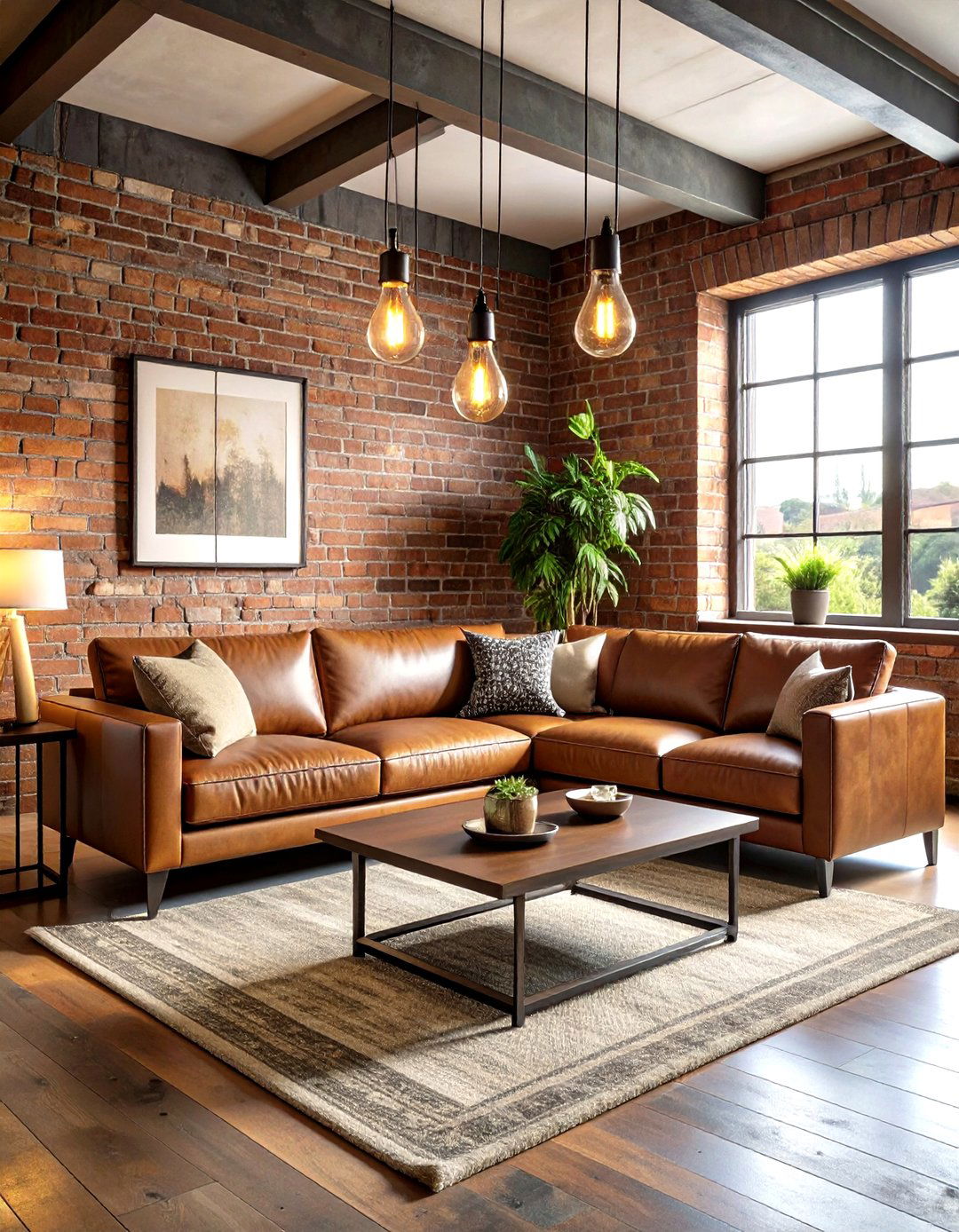
The warmth of exposed brick walls creates an instant focal point that defines industrial living spaces with authentic character. These living rooms feature original brick or carefully installed brick veneer that adds texture and visual interest to modern furniture arrangements. The rough, earthy surface provides a perfect backdrop for contemporary seating, allowing sleek leather sofas and metal coffee tables to shine against the rustic foundation. Lighting plays a crucial role, with Edison bulb fixtures and metal pendant lights casting warm shadows across the textured surfaces. The color scheme builds upon the natural brick tones, incorporating deep grays, warm browns, and crisp whites to create a balanced environment. Open floor plans maximize the impact of brick walls, allowing the texture to flow throughout connected spaces while maintaining the loft-like atmosphere that defines industrial style.
2. Steel Beam Ceiling Design
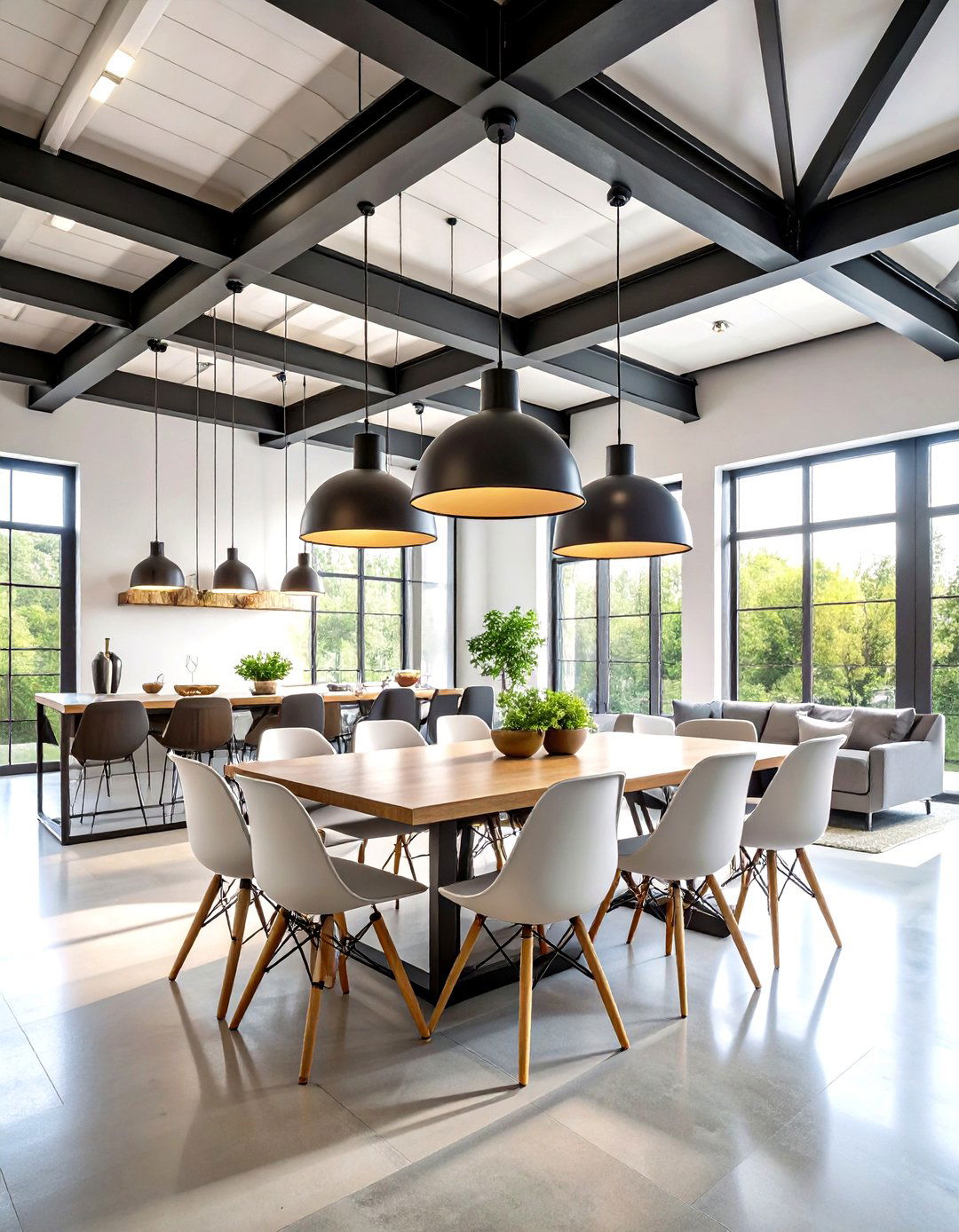
Why settle for hidden structural elements when exposed steel beams can become the architectural stars of your space? These industrial ceiling designs celebrate the building's skeleton, turning utilitarian support structures into dramatic design features that command attention. The dark metal framework creates strong geometric lines across white or concrete ceilings, establishing a bold contrast that emphasizes the room's proportions. These spaces typically feature high ceilings that accommodate oversized furniture and statement lighting fixtures suspended from the steel framework. The industrial aesthetic extends through carefully chosen furnishings, including metal dining tables, leather seating, and vintage factory-inspired accessories. Paint colors remain intentionally subdued, allowing the steel beams to serve as the primary decorative element while warm wood accents and soft textiles prevent the space from feeling cold or unwelcoming.
3. Concrete Floor Dining Areas
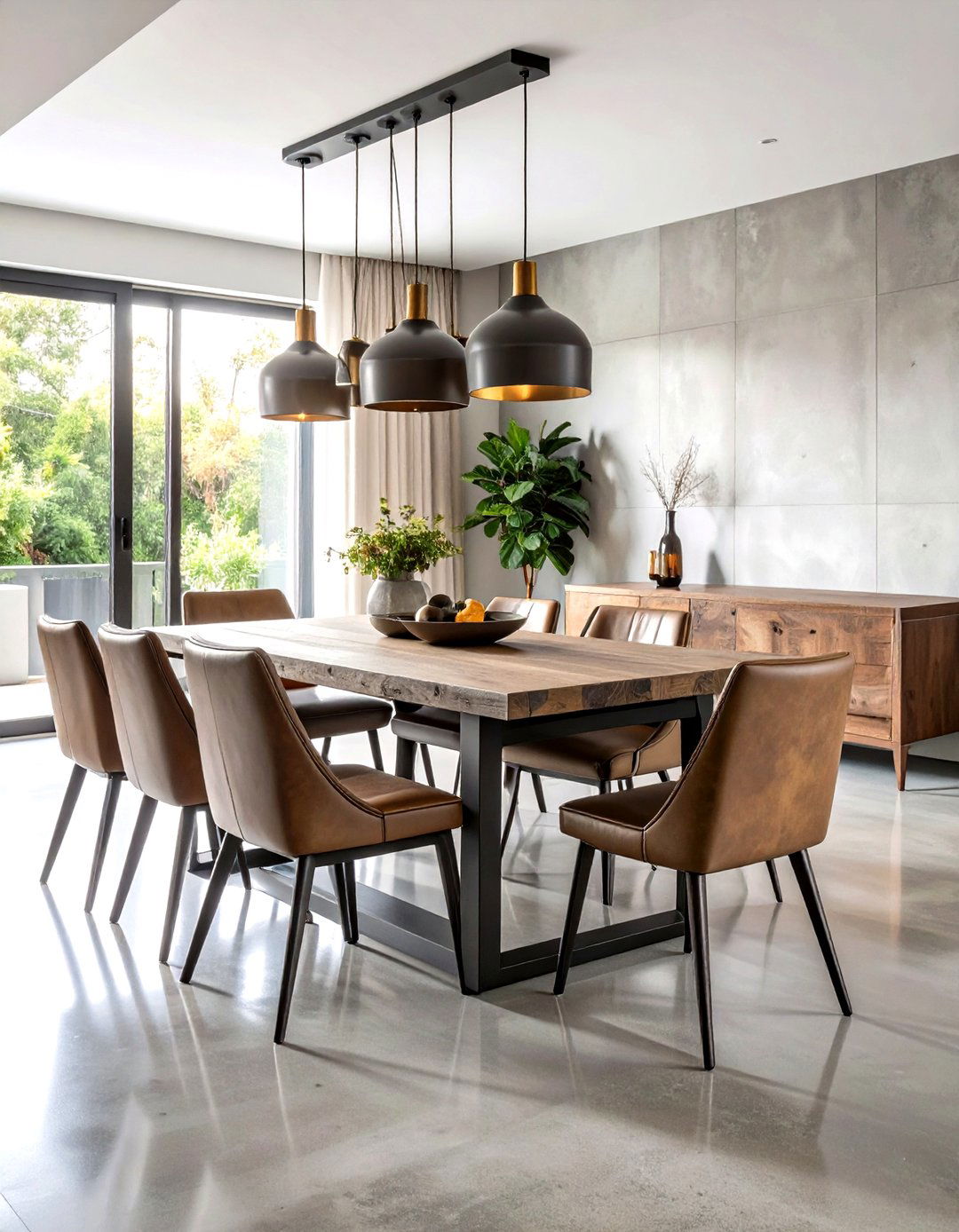
Polished concrete floors establish the foundation for sophisticated industrial dining spaces that prioritize both durability and style. These surfaces offer practical benefits including easy maintenance and excellent heat retention, while their smooth gray finish provides a neutral canvas for bold furniture choices. The dining area becomes a showcase for mixed materials, featuring reclaimed wood tables with steel bases, leather dining chairs, and industrial-style pendant lighting that creates intimate atmosphere over meal spaces. Does your dining room need a complete transformation that combines elegance with everyday practicality? The concrete's natural variations and subtle aggregate patterns add visual texture without overwhelming the space, while area rugs can define seating zones and introduce warmth through natural fibers. Storage solutions include metal shelving units and vintage industrial cabinets that maintain the utilitarian aesthetic while providing functional display space.
4. Industrial Kitchen Islands

Metal-framed kitchen islands with reclaimed wood tops serve as commanding centerpieces that combine workspace functionality with authentic industrial appeal. These substantial pieces typically feature lower storage areas enclosed by metal mesh or glass panels, allowing kitchen equipment and dishware to become part of the decorative display. The contrast between warm wood surfaces and cool metal frameworks creates visual interest while providing durable work surfaces suitable for food preparation and casual dining. Industrial-style bar stools with adjustable heights complement the island's utilitarian design, often featuring leather seats and metal bases that match the island's framework. Overhead lighting includes oversized pendant fixtures with metal shades or exposed Edison bulbs that provide task lighting while reinforcing the factory-inspired aesthetic throughout the kitchen space.
5. Exposed Pipe Bathroom Vanities

Bathroom vanities featuring exposed plumbing transform functional necessities into distinctive design elements that celebrate industrial authenticity. These installations showcase copper, brass, or black iron pipes as integral parts of the vanity design, eliminating traditional plumbing concealment in favor of honest material expression. The contrast between raw piping and refined surfaces like concrete or wood countertops creates compelling visual tension that defines industrial bathroom design. Floating vanities with exposed pipe supports maximize floor space while maintaining the utilitarian aesthetic, often paired with metal-framed mirrors and vintage-inspired lighting fixtures. What could be more authentic than embracing the very systems that make your bathroom functional? Storage solutions integrate seamlessly with the exposed plumbing, featuring open shelving and metal baskets that complement the industrial framework while providing practical organization for bathroom essentials.
6. Warehouse Window Walls
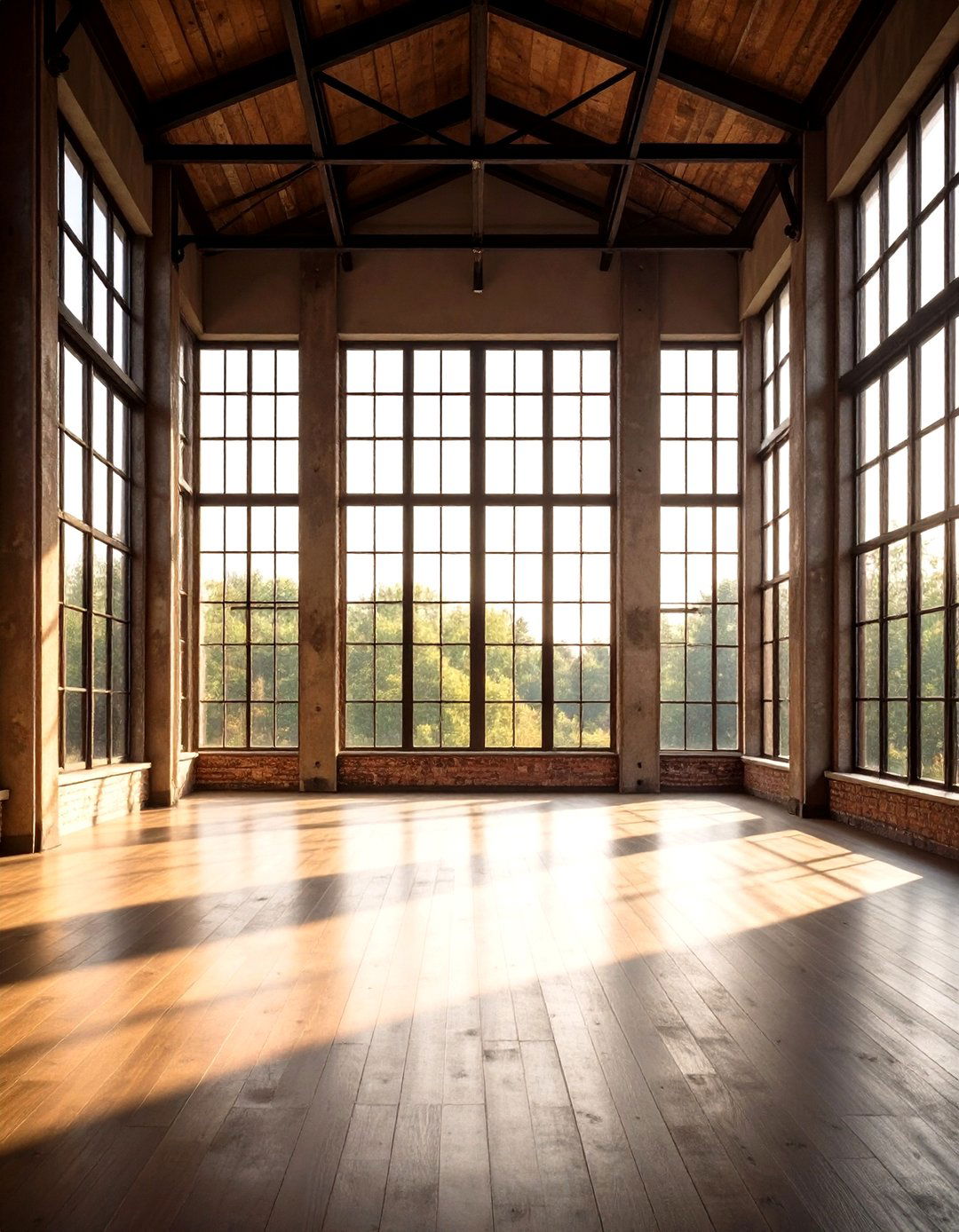
Floor-to-ceiling steel-framed windows create dramatic focal points that flood industrial spaces with natural light while maintaining authentic factory aesthetics. These expansive window installations feature multiple panes separated by dark metal mullions, often incorporating operable sections for ventilation and connection to outdoor spaces. The geometric grid pattern of window frames becomes a design element itself, casting interesting shadow patterns throughout the day while framing exterior views as living artwork. Interior spaces benefit from the abundant natural light, which enhances the textures of exposed brick, concrete, and metal surfaces throughout the room. The industrial window treatment extends to interior applications, where similar steel frames can divide spaces while maintaining visual connection and light flow between areas.
7. Edison Bulb Lighting Systems

Vintage-inspired Edison bulb fixtures create warm, atmospheric lighting that perfectly complements industrial decor while providing both functional illumination and decorative interest. These installations range from simple pendant clusters to elaborate chandelier arrangements, often featuring exposed wiring and metal fixtures that celebrate electrical components as design elements. The warm amber glow of filament bulbs softens harsh industrial materials like concrete and steel, creating inviting environments suitable for both work and relaxation. Track lighting systems with adjustable Edison bulb fixtures offer flexibility for highlighting artwork or architectural features while maintaining the industrial aesthetic. Can lighting truly transform the entire mood of your industrial space? Multiple fixture types work together to create layered lighting schemes, combining overhead pendants, wall-mounted sconces, and table lamps featuring similar bulb styles and metal construction details.
8. Reclaimed Wood Accent Walls
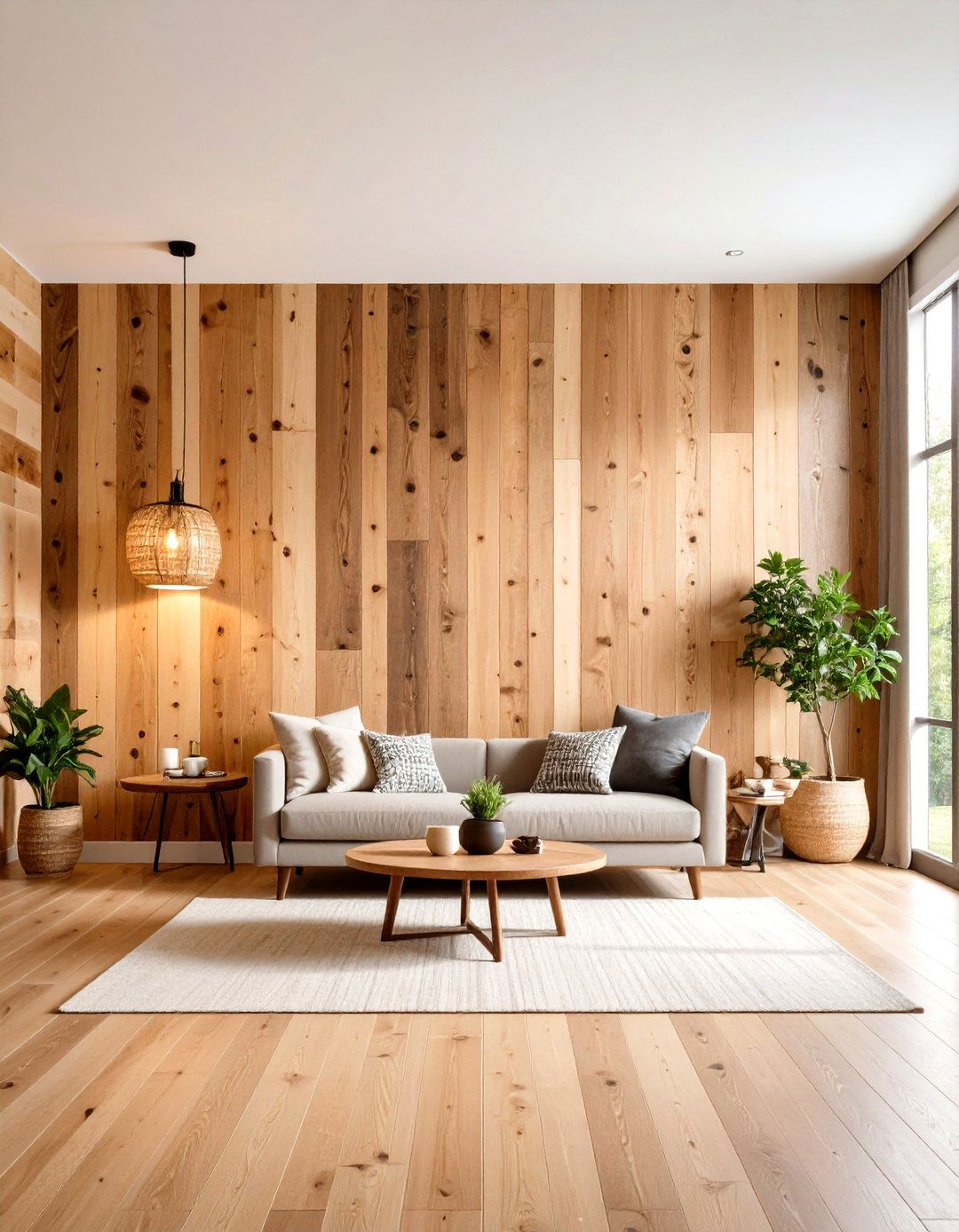
Weathered wood paneling introduces natural warmth and textural contrast to industrial spaces dominated by hard surfaces and cool materials. These accent walls feature reclaimed barn wood, old flooring materials, or salvaged lumber that tells the story of previous use through visible wear patterns, nail holes, and natural patina. The installation typically covers one prominent wall, creating a focal point that balances the cooler tones of metal and concrete elements throughout the space. Furniture selections emphasize the wood's rustic qualities, featuring pieces that combine reclaimed lumber with industrial metal frameworks. The natural variations in wood grain and color create organic patterns that soften geometric industrial elements while maintaining authentic material expression. Lighting design highlights the wood's texture through strategically placed fixtures that cast dramatic shadows across the paneled surface.
9. Metal Shelving Storage Solutions
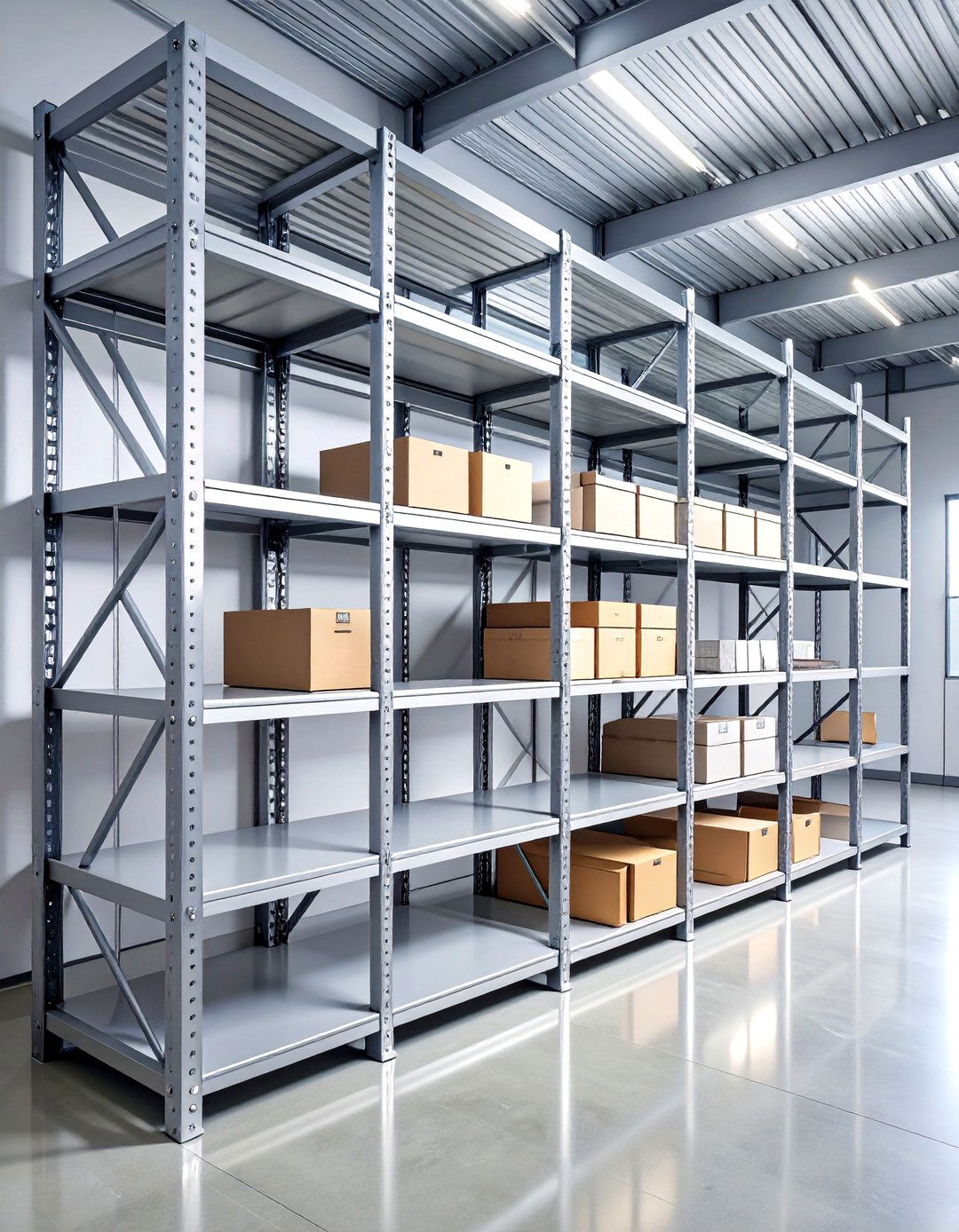
Open metal shelving systems provide practical storage while reinforcing industrial aesthetics through honest material expression and utilitarian design principles. These installations feature steel or iron frameworks with adjustable shelving that adapts to changing storage needs while maintaining clean, geometric lines throughout the space. The transparency of open shelving prevents visual clutter while allowing stored items to become part of the room's decorative scheme, encouraging thoughtful organization and display of books, kitchenware, or collectibles. Industrial spaces benefit from the vertical storage opportunities these systems provide, maximizing floor space while creating opportunities for displaying items that reinforce the overall design theme. Does your space need storage solutions that work as hard as they look? Multiple shelving configurations work together to create comprehensive storage walls that serve specific functional needs while contributing to the room's industrial character.
10. Leather Furniture Collections
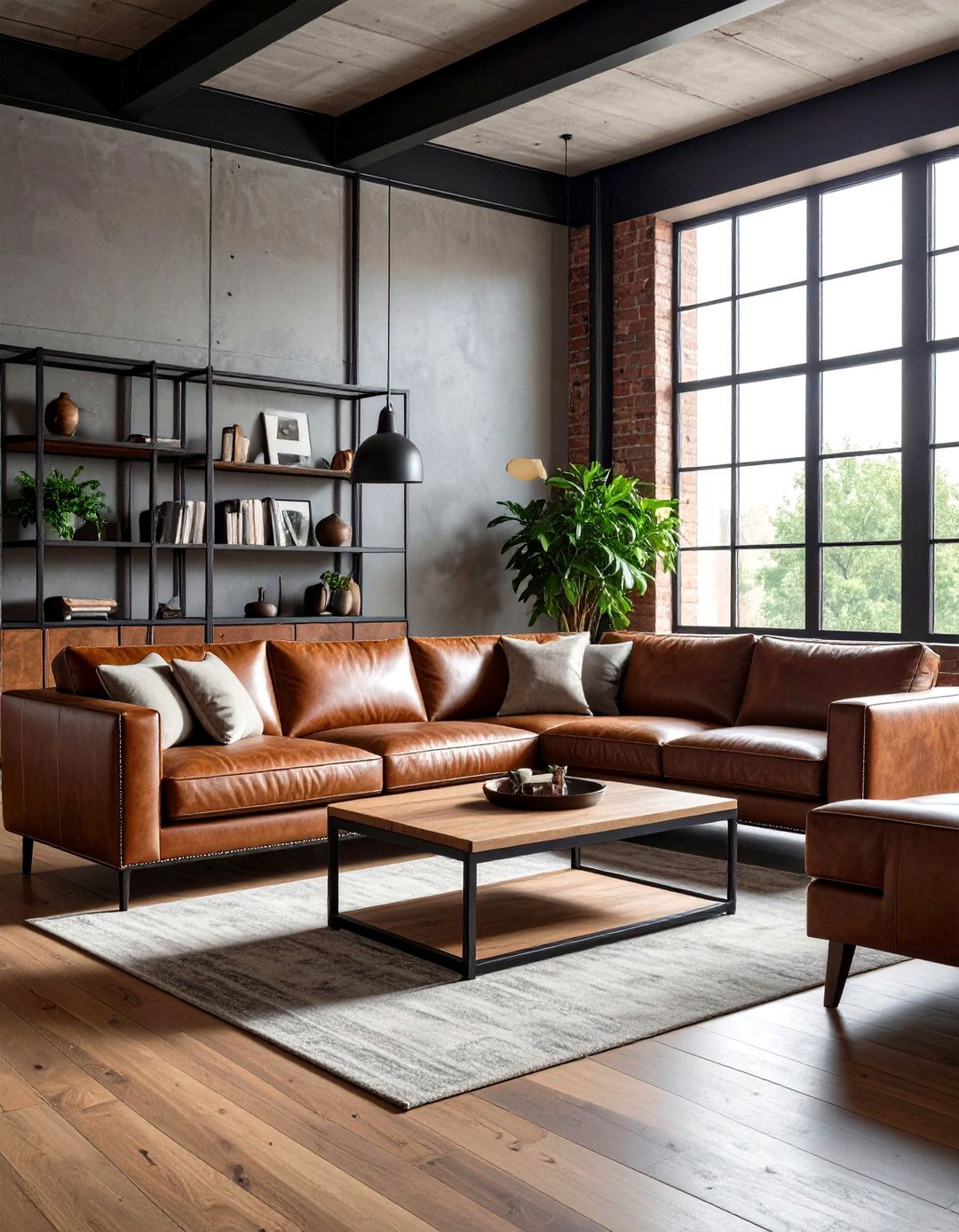
Rich leather seating establishes sophisticated comfort within industrial spaces while introducing natural materials that age beautifully over time. These furniture collections typically feature deep brown or black leather upholstery over metal or wooden frames, creating pieces that combine durability with visual warmth. The natural variations and patina development in quality leather complement the authentic wear patterns found in reclaimed wood and vintage metal elements throughout industrial interiors. Furniture arrangements emphasize the substantial nature of leather pieces, often featuring oversized sofas and armchairs that provide generous seating while anchoring open floor plans. The maintenance requirements of leather furniture align with industrial design principles, improving with age and developing character through regular use. Accent pieces include leather ottomans, benches, and storage chests that extend the material palette while providing additional functionality.
11. Industrial Bedroom Lofts
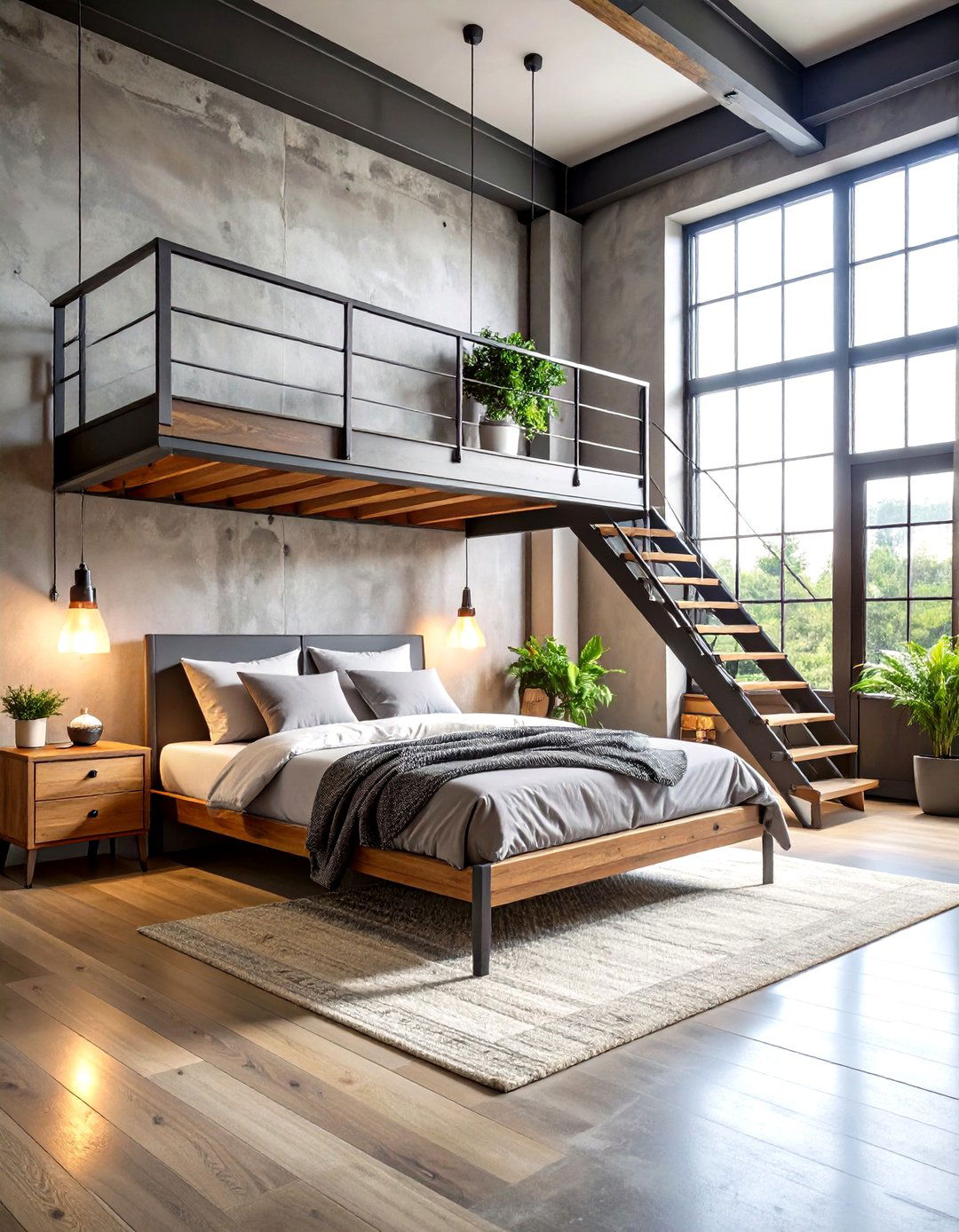
Elevated sleeping areas maximize vertical space while creating intimate retreats within larger industrial environments. These loft installations typically feature steel staircases or ladder access leading to sleeping platforms supported by exposed metal frameworks that celebrate structural elements as design features. The bedroom area maintains industrial aesthetics through materials like steel bed frames, concrete floors, and exposed ductwork or beams overhead. Privacy screens made from metal mesh, reclaimed wood, or industrial fabric panels define the sleeping area without completely enclosing the space. Storage solutions integrate with the loft structure, featuring built-in wardrobes, under-stair storage, and hanging systems that maximize efficiency in compact areas. Lighting design includes pendant fixtures suspended from the structural framework and wall-mounted reading lights that provide task illumination while maintaining the industrial aesthetic throughout the elevated sleeping space.
12. Concrete Countertop Kitchens
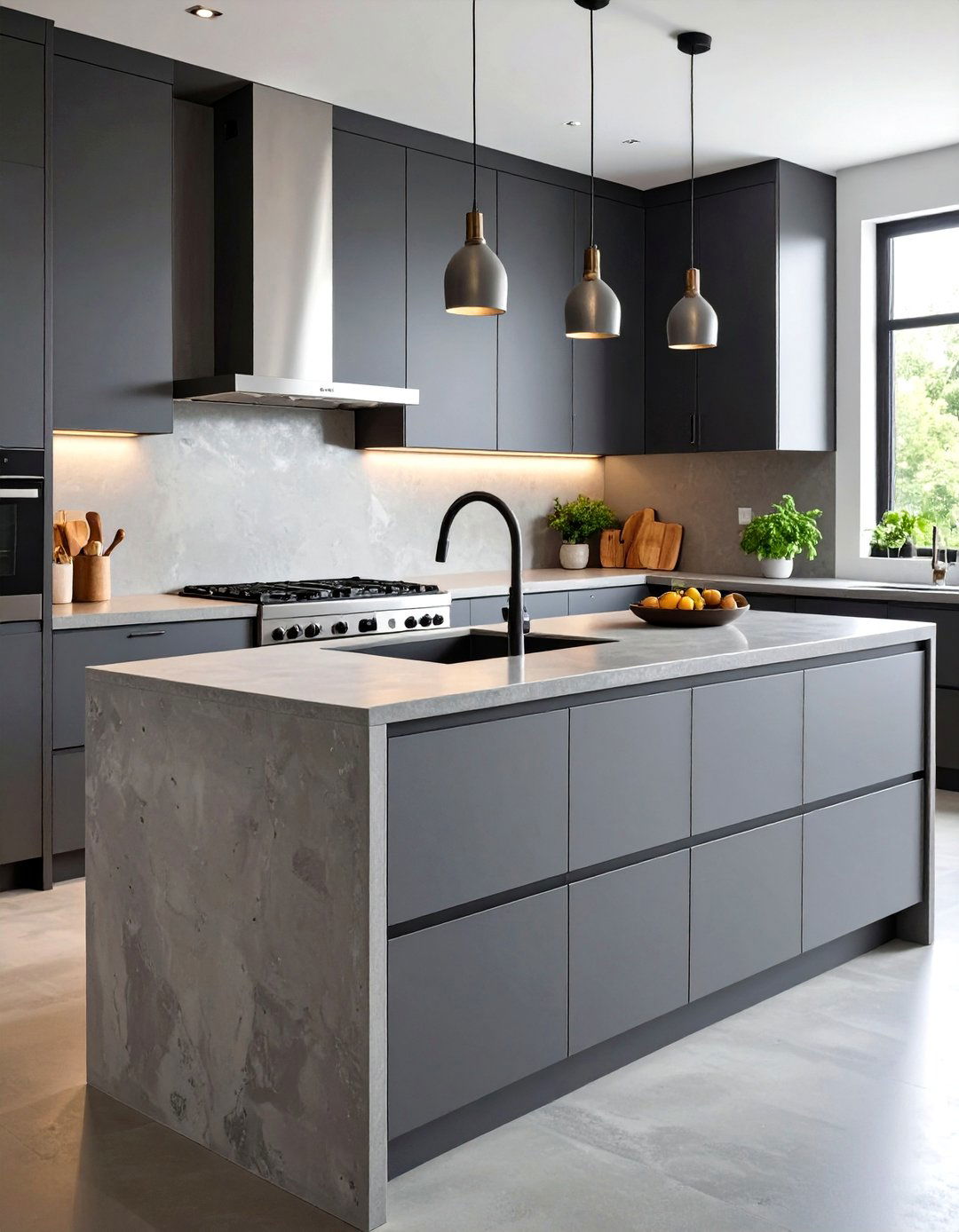
Seamless concrete surfaces provide durable, heat-resistant work areas that embrace industrial materials while offering endless customization possibilities through texture, color, and integral design elements. These installations feature poured-in-place or precast concrete sections that eliminate seams and create smooth, monolithic surfaces perfect for food preparation and casual dining. The natural variations in concrete create subtle visual interest while maintaining the clean lines essential to industrial kitchen design. Sink integration becomes seamless with concrete countertops, often featuring undermount or integrated sink designs that continue the monolithic surface treatment. What makes concrete the perfect choice for serious home cooks who appreciate industrial style? Edge details, aggregate exposure, and surface treatments allow customization while maintaining authentic material expression that complements metal cabinetry, exposed shelving, and industrial lighting fixtures throughout the kitchen space.
13. Factory Window Room Dividers
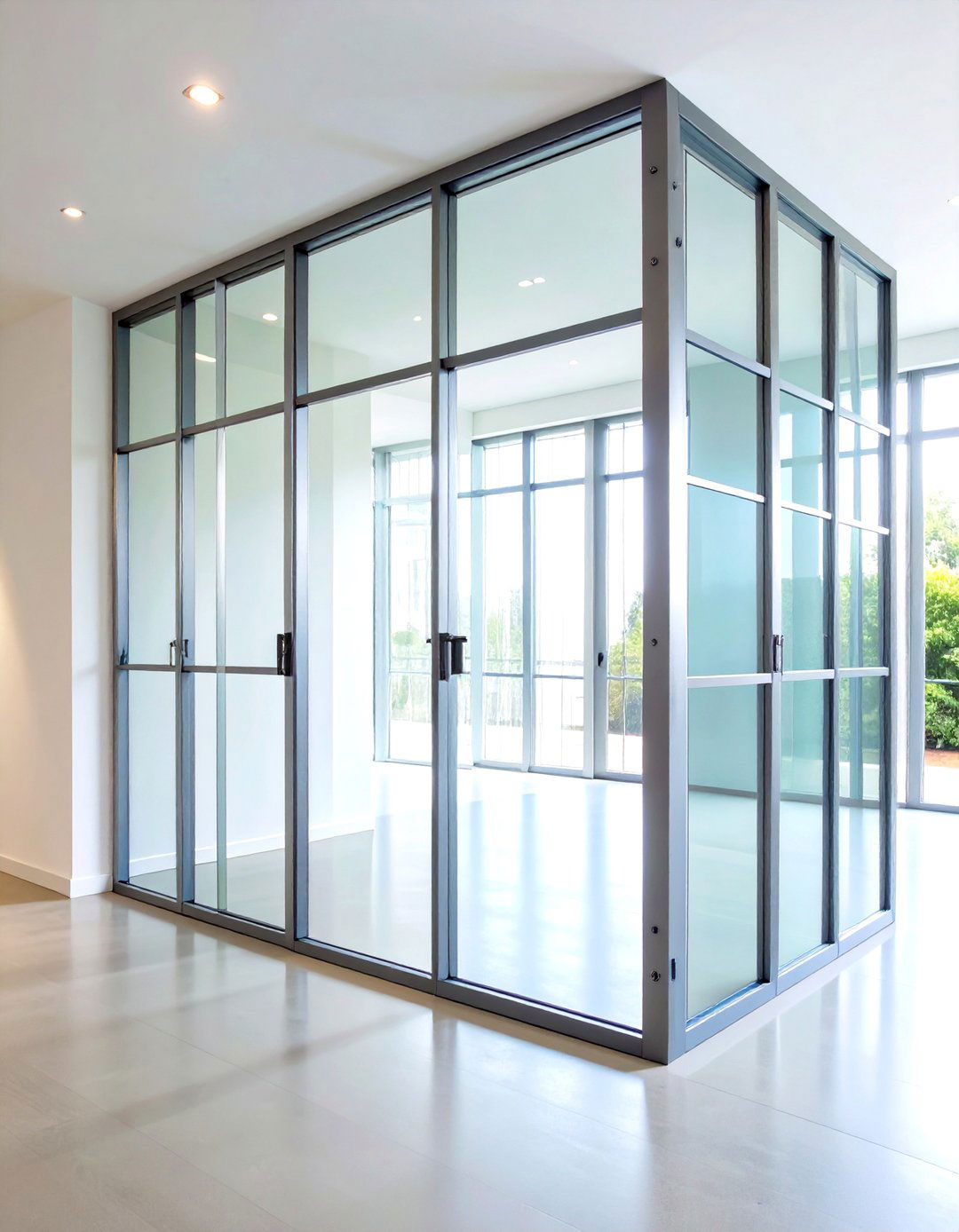
Interior steel-framed windows create transparent boundaries that define spaces while maintaining visual connection and light flow throughout open industrial floor plans. These installations draw inspiration from factory architecture, featuring multiple panes within dark metal frameworks that add geometric interest while preserving the sense of spaciousness. The transparency of glass panels prevents the compartmentalization that solid walls create, allowing each area to benefit from natural light sources while maintaining distinct functional zones. Hardware details include industrial-style handles, hinges, and locking mechanisms that reinforce the factory aesthetic while providing practical operation. Installation options include floor-to-ceiling panels, partial height dividers, and sliding systems that offer flexibility in space configuration. The window panels can incorporate different glass types, including clear, frosted, or textured options that adjust privacy levels while maintaining the overall design integrity.
14. Copper Pipe Fixtures
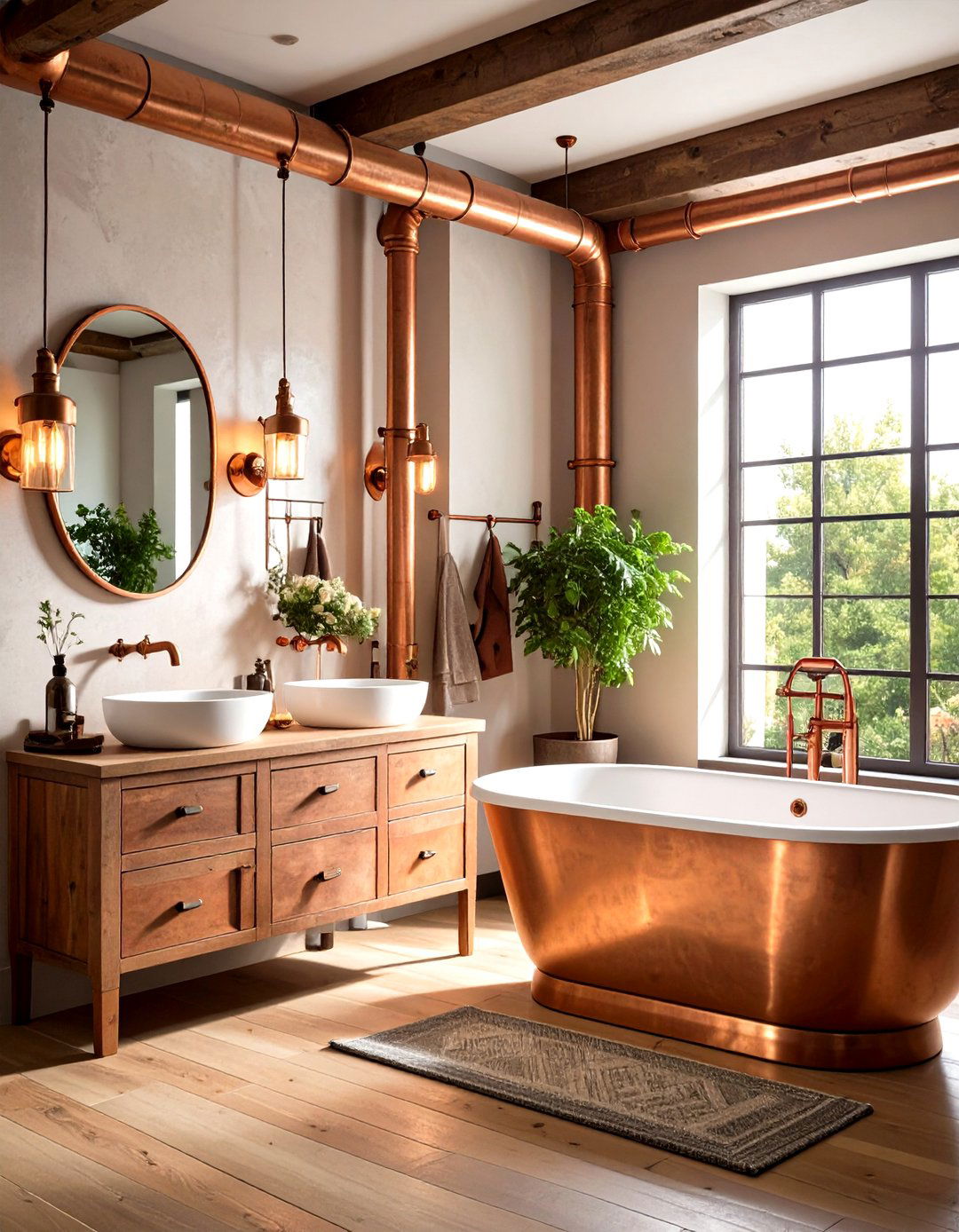
Warm copper elements introduce metallic sophistication while developing natural patina that enhances character over time. These installations feature exposed copper plumbing, lighting fixtures, and decorative elements that celebrate the material's natural beauty and practical applications. The reddish-brown tones of new copper gradually develop green patina, creating evolving surfaces that add visual interest and authentic aging to industrial interiors. Bathroom applications showcase copper through exposed shower systems, faucets, and towel warming systems that combine functionality with decorative appeal. Kitchen installations might include copper range hoods, sink fixtures, and open shelving supports that complement stainless steel appliances while adding warmth. The maintenance of copper fixtures becomes part of the design story, with users choosing between regular polishing to maintain brightness or allowing natural patination to develop authentic character that reflects time and use.
15. Corrugated Metal Wall Panels
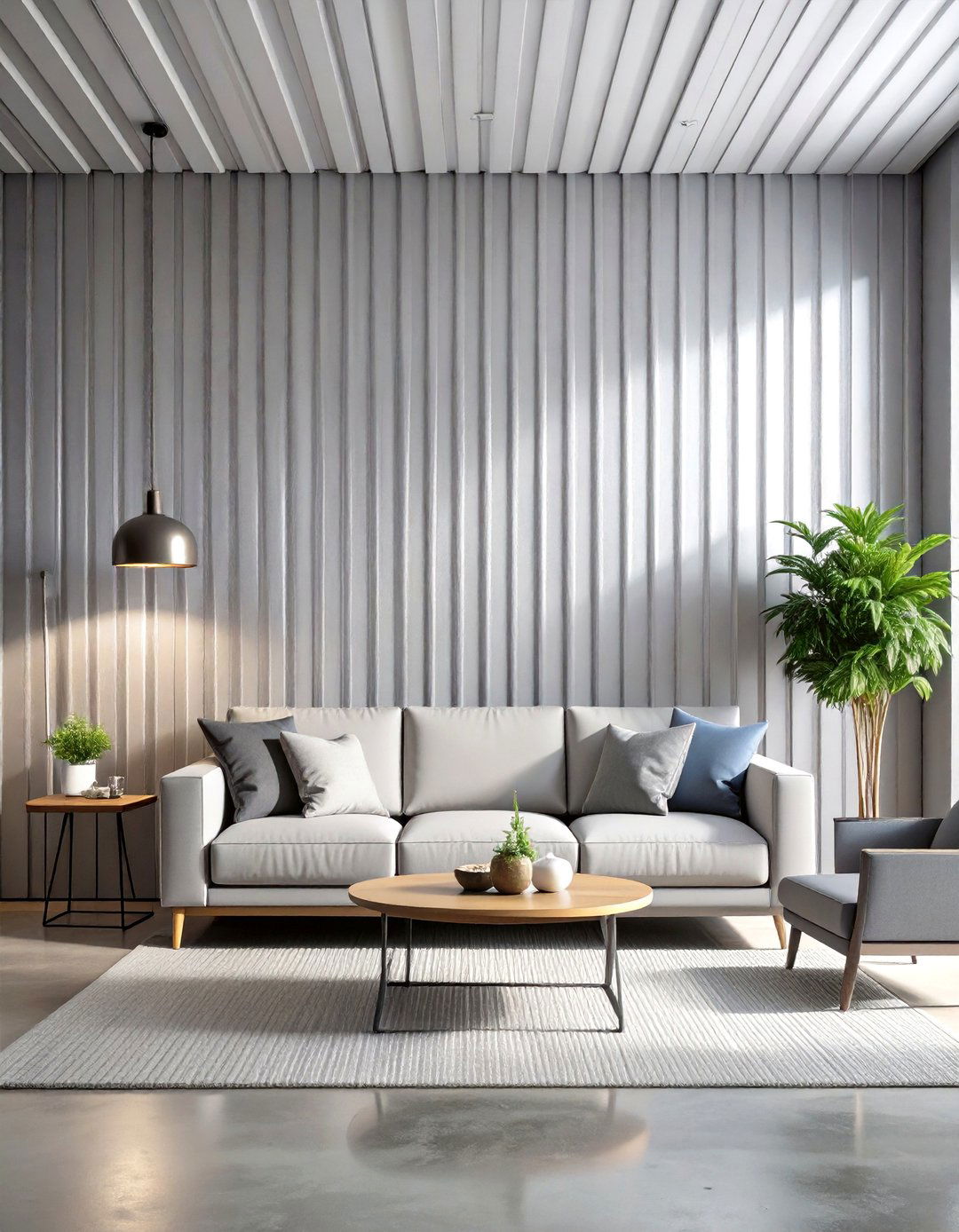
Textured metal surfaces add dimensional interest and authentic industrial character through materials commonly found in warehouse and factory construction. These installations feature corrugated steel or aluminum panels that create linear shadow patterns while introducing durable, low-maintenance surfaces perfect for high-traffic areas. The vertical or horizontal orientation of corrugations can emphasize room proportions while creating visual rhythm across large wall areas. Color options include natural metal finishes, painted surfaces in industrial color palettes, or weathered treatments that simulate aged exposure. The panels work particularly well as accent walls behind beds, in dining areas, or as kitchen backsplashes where their practical benefits complement their aesthetic appeal. Installation systems accommodate different mounting methods while ensuring proper thermal expansion and moisture management. How can simple warehouse materials transform your space into an authentic industrial environment?
16. Cast Iron Decorative Elements
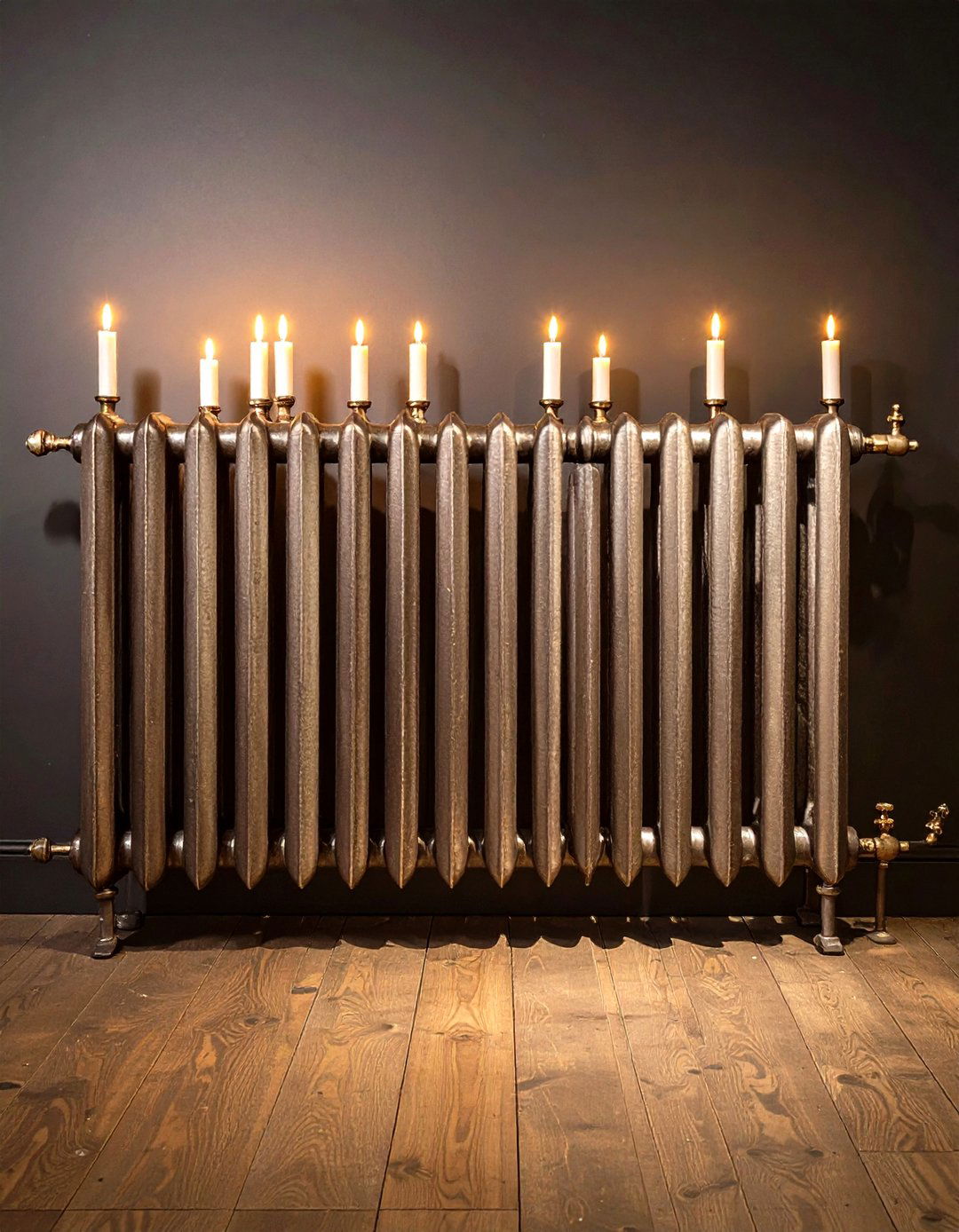
Vintage cast iron pieces introduce authentic period details while providing functional elements that celebrate industrial manufacturing heritage. These installations feature architectural salvage items like radiators, decorative brackets, machinery parts, and hardware that tell stories of previous industrial use. The substantial weight and detailed casting work of quality iron pieces create focal points that anchor furniture arrangements while providing conversation starters for guests. Restoration processes can maintain original finishes or update pieces with contemporary coatings that preserve character while improving durability. The integration of cast iron elements requires careful planning to accommodate weight requirements while ensuring proper installation techniques. Display strategies highlight the sculptural qualities of industrial machinery parts, vintage tools, and architectural elements that serve as functional art throughout the space while reinforcing authentic material expression.
17. Industrial Workspace Studios
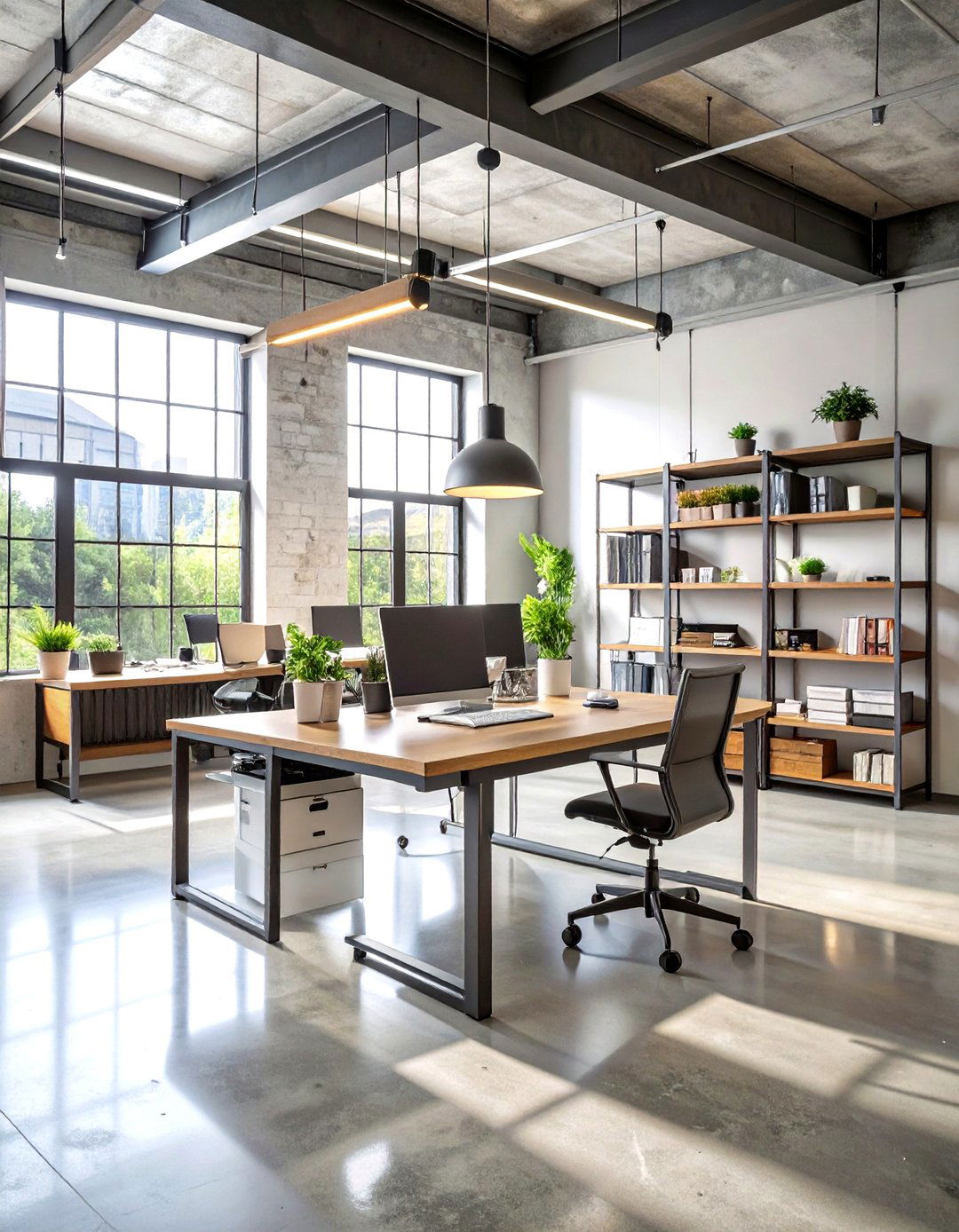
Multi-functional areas combine living and working environments through furniture systems that adapt to changing needs while maintaining industrial aesthetics throughout all activities. These installations feature height-adjustable tables, mobile storage systems, and flexible lighting solutions that accommodate both professional work and personal activities. The workspace integrates with living areas through material continuity, using steel shelving, concrete surfaces, and leather seating that transition seamlessly between work and relaxation modes. Technology integration includes concealed cable management, industrial-style computer accessories, and charging stations that maintain clean lines while providing modern functionality. Storage solutions emphasize accessibility and organization, featuring open shelving systems, mobile drawer units, and wall-mounted organizers that keep supplies visible and easily accessible. Can your living space accommodate serious work demands while maintaining residential comfort? The design celebrates productivity through honest material expression and functional furniture that serves multiple purposes efficiently.
18. Raw Steel Staircase Designs
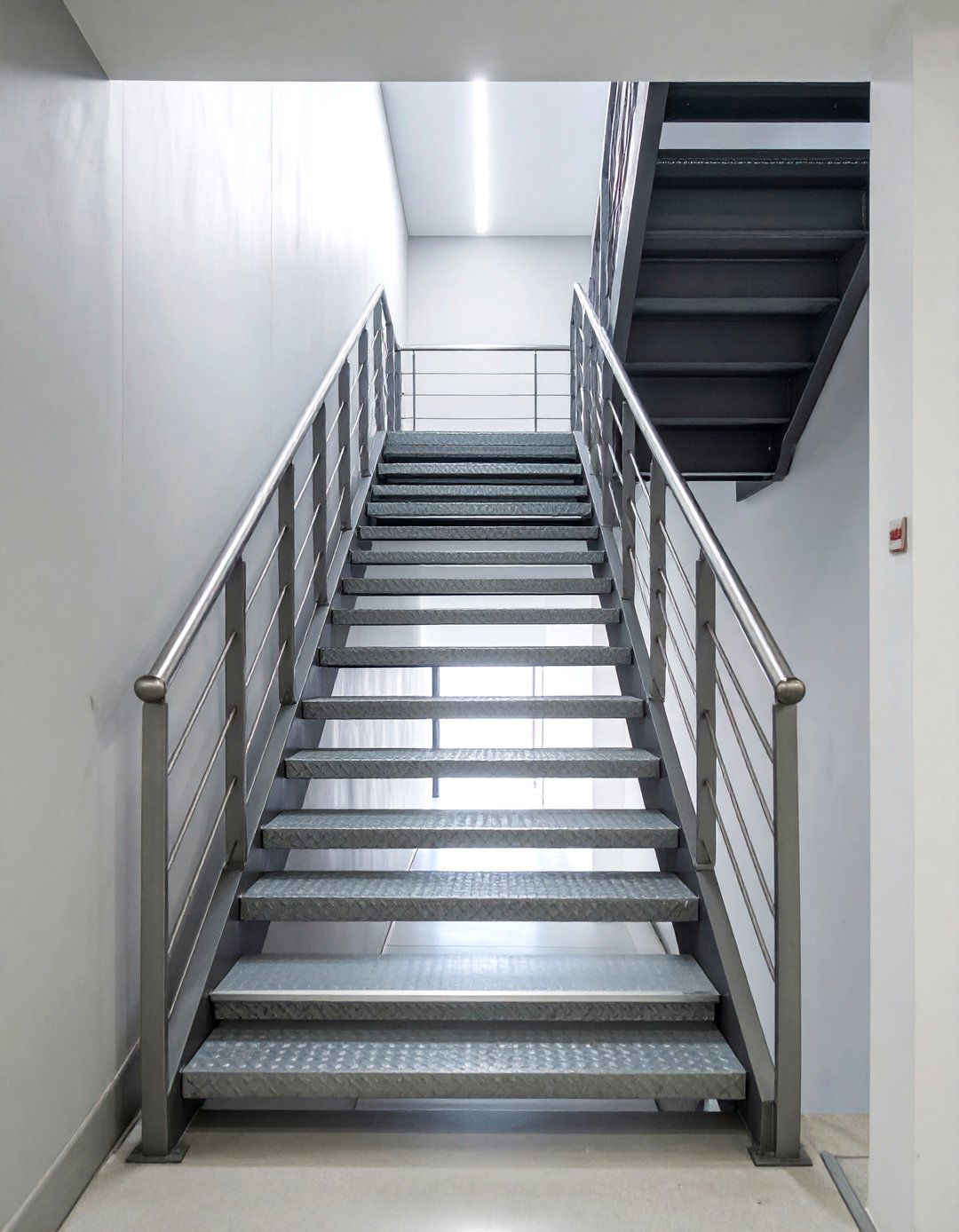
Exposed metal staircases become sculptural elements that celebrate structural engineering while providing vertical circulation within industrial spaces. These installations feature steel plate treads, tube steel railings, and minimal support structures that emphasize clean geometric lines and honest material expression. The transparency of open riser designs maintains visual connection between floor levels while allowing light to flow throughout vertical spaces. Fabrication details showcase welding techniques, connection methods, and finishing treatments that celebrate industrial manufacturing processes. Safety features integrate seamlessly with design elements, including code-compliant railings and slip-resistant tread surfaces that maintain aesthetic integrity. The staircase design often extends to surrounding spaces through material continuity, featuring matching steel elements in railings, light fixtures, and furniture pieces that create cohesive environments. Maintenance requirements align with industrial design principles, improving with age while developing authentic patina through regular use.
19. Vintage Industrial Lighting
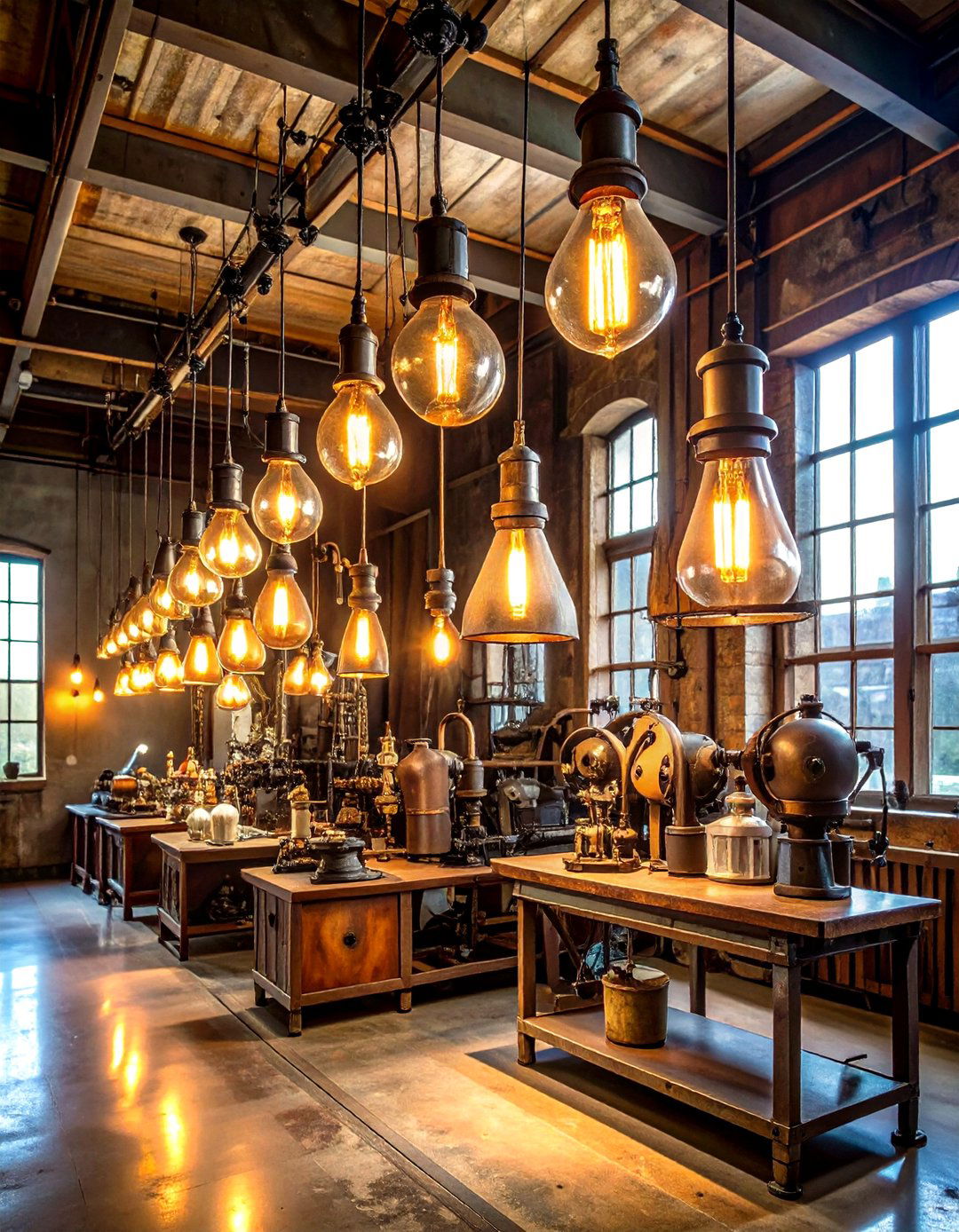
Period-appropriate fixtures create authentic atmosphere while providing practical illumination that celebrates industrial manufacturing heritage. These installations feature restored factory lights, salvaged electrical equipment, and reproduction pieces that maintain historical accuracy while meeting contemporary safety standards. The substantial construction and honest material expression of industrial lighting create focal points that anchor furniture arrangements while providing both ambient and task illumination. Pendant clusters over dining areas, track systems for artwork display, and accent lighting for architectural features work together to create layered lighting schemes. What stories do authentic vintage fixtures tell about industrial work environments? Installation considerations include proper electrical updates, weight support requirements, and historical preservation techniques that maintain original character while ensuring safe operation. The patina and wear patterns of authentic pieces create unique character that cannot be replicated through new manufacturing.
20. Concrete Block Interior Walls
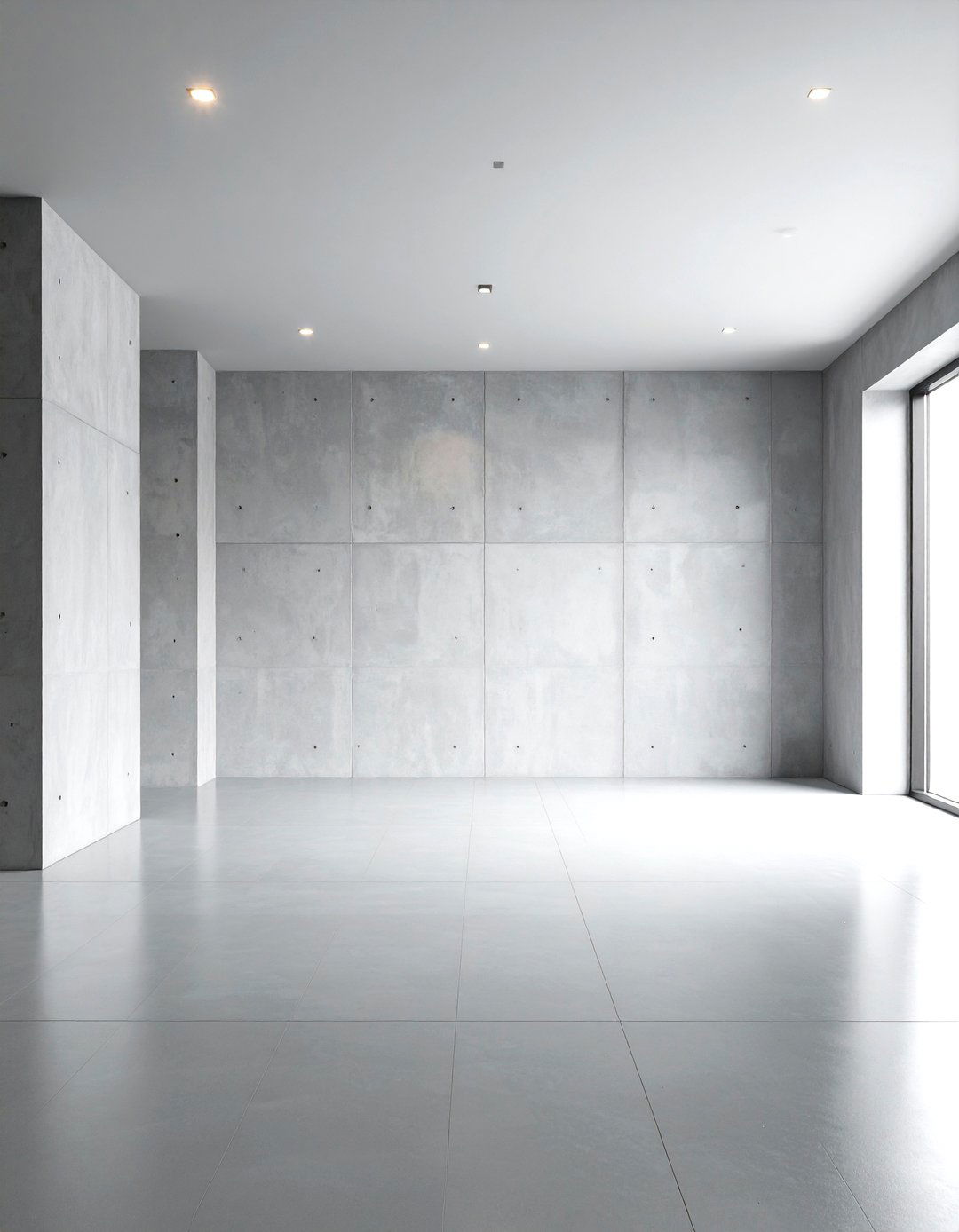
Structural masonry units create authentic industrial surfaces while providing thermal mass and sound insulation benefits that enhance living comfort. These installations feature standard concrete blocks or specialty units with enhanced surface textures that add visual interest while maintaining honest material expression. The modular nature of block construction allows creative patterns, integrated shelving systems, and architectural details that customize surfaces while preserving authentic industrial character. Surface treatments include natural gray finishes, painted surfaces in industrial color palettes, or specialty sealers that enhance durability while maintaining texture. The thermal properties of masonry construction provide energy efficiency benefits while creating substantial walls that define spaces with authority. Integration with other industrial materials includes steel lintels, exposed conduit systems, and metal accent panels that celebrate construction techniques while providing practical benefits. Construction techniques accommodate plumbing and electrical systems while maintaining clean surface expression.
21. Mixed Metal Accent Combinations

Strategic metallic contrasts create visual interest through the thoughtful combination of different metal finishes and manufacturing processes. These installations feature copper, brass, steel, and iron elements that work together to create rich material palettes without overwhelming spaces with competing finishes. The patina development of different metals creates evolving surfaces that gain character over time while maintaining harmony through careful selection and placement. Hardware details include mixed metal door handles, light fixtures, and furniture accents that demonstrate sophisticated understanding of material relationships. The combination extends to larger elements like steel shelving with copper pipe supports, brass light fixtures with steel mounting systems, and iron furniture with copper detail accents. How do different metals age together to create authentic industrial character? Maintenance strategies preserve the natural aging process while preventing deterioration that could compromise structural integrity or aesthetic appeal.
22. Industrial Textile Integration
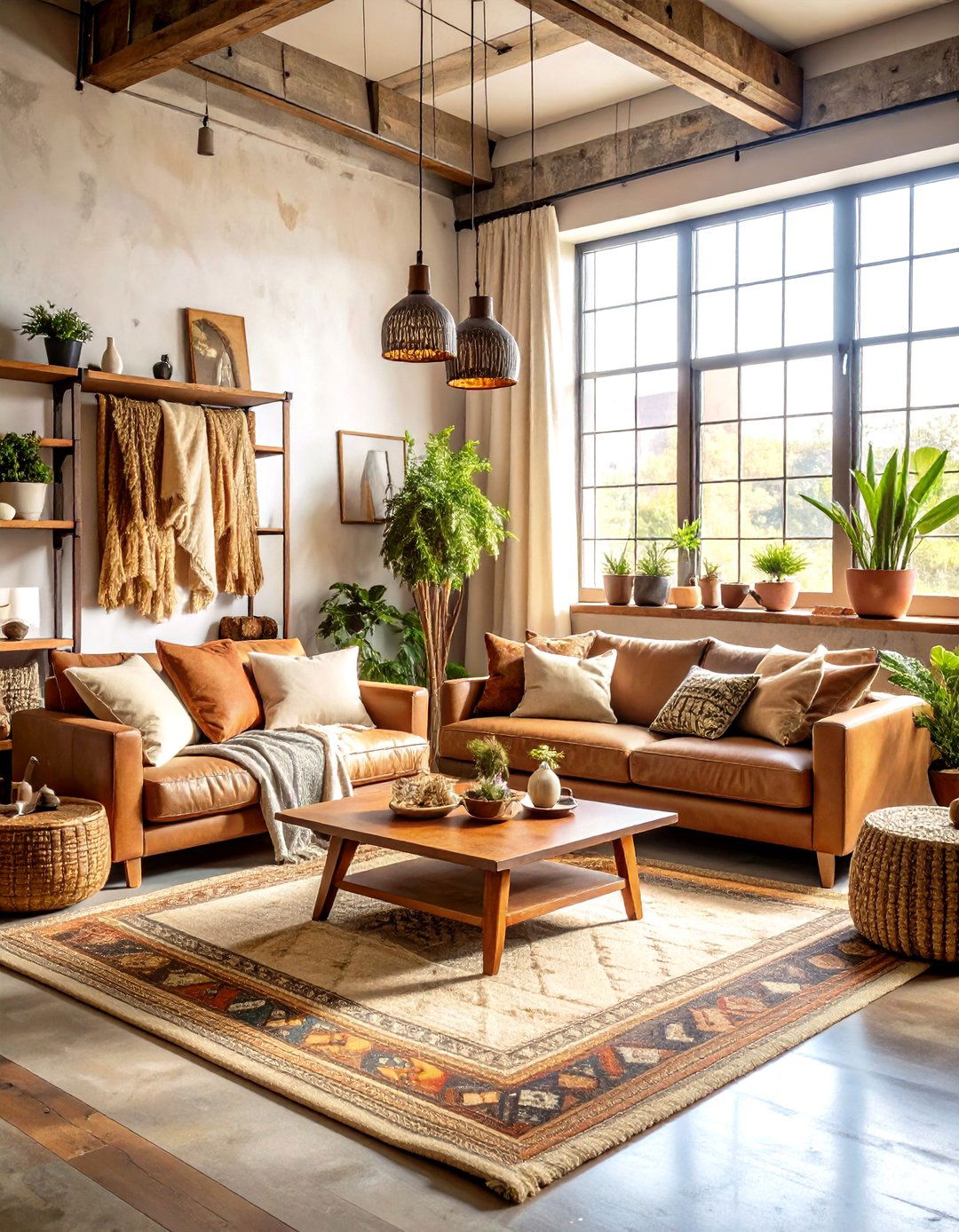
Carefully selected fabrics introduce warmth and comfort while maintaining authentic industrial character through natural materials and minimal pattern work. These installations feature canvas, leather, wool, and linen textiles that age gracefully while providing practical benefits like sound absorption and thermal comfort. The neutral color palettes of industrial textiles complement metal and concrete surfaces while avoiding pattern complications that could compete with architectural elements. Upholstery applications include leather seating with visible stitching details, canvas cushions with industrial hardware, and wool blankets with simple geometric patterns. Window treatments emphasize function over decoration, featuring canvas panels, metal hardware systems, and motorized controls that integrate with home automation systems. Storage solutions for textiles include open shelving systems, vintage industrial laundry equipment, and metal storage containers that maintain organization while contributing to overall design themes.
23. Open Shelving Display Systems
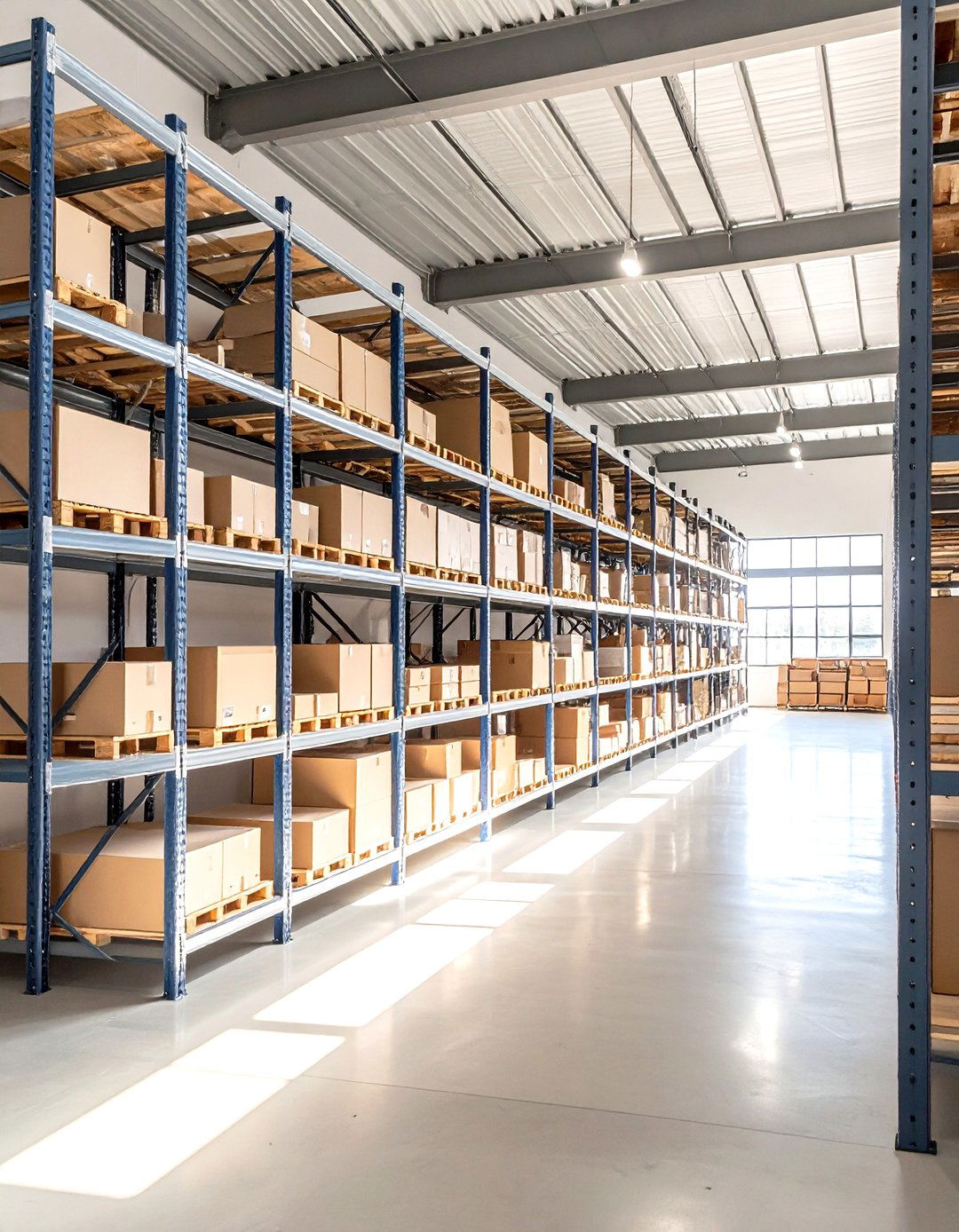
Transparent storage solutions celebrate organization while allowing collections and functional items to contribute to overall design schemes through thoughtful arrangement and display techniques. These installations feature adjustable steel shelving systems that adapt to changing needs while maintaining clean geometric lines throughout storage areas. The display strategy emphasizes curation over accumulation, featuring carefully selected items that reinforce industrial themes while serving practical purposes. Book collections, dishware displays, and tool organization become decorative elements that reflect personal interests while maintaining authentic industrial character. Color coordination within displayed items creates visual harmony while allowing individual pieces to contribute unique character and story. What makes everyday objects worthy of display in industrial environments? Lighting integration includes shelf-mounted fixtures, display spotlights, and accent systems that highlight collections while providing practical illumination for daily use throughout storage areas.
24. Weathered Metal Art Installations
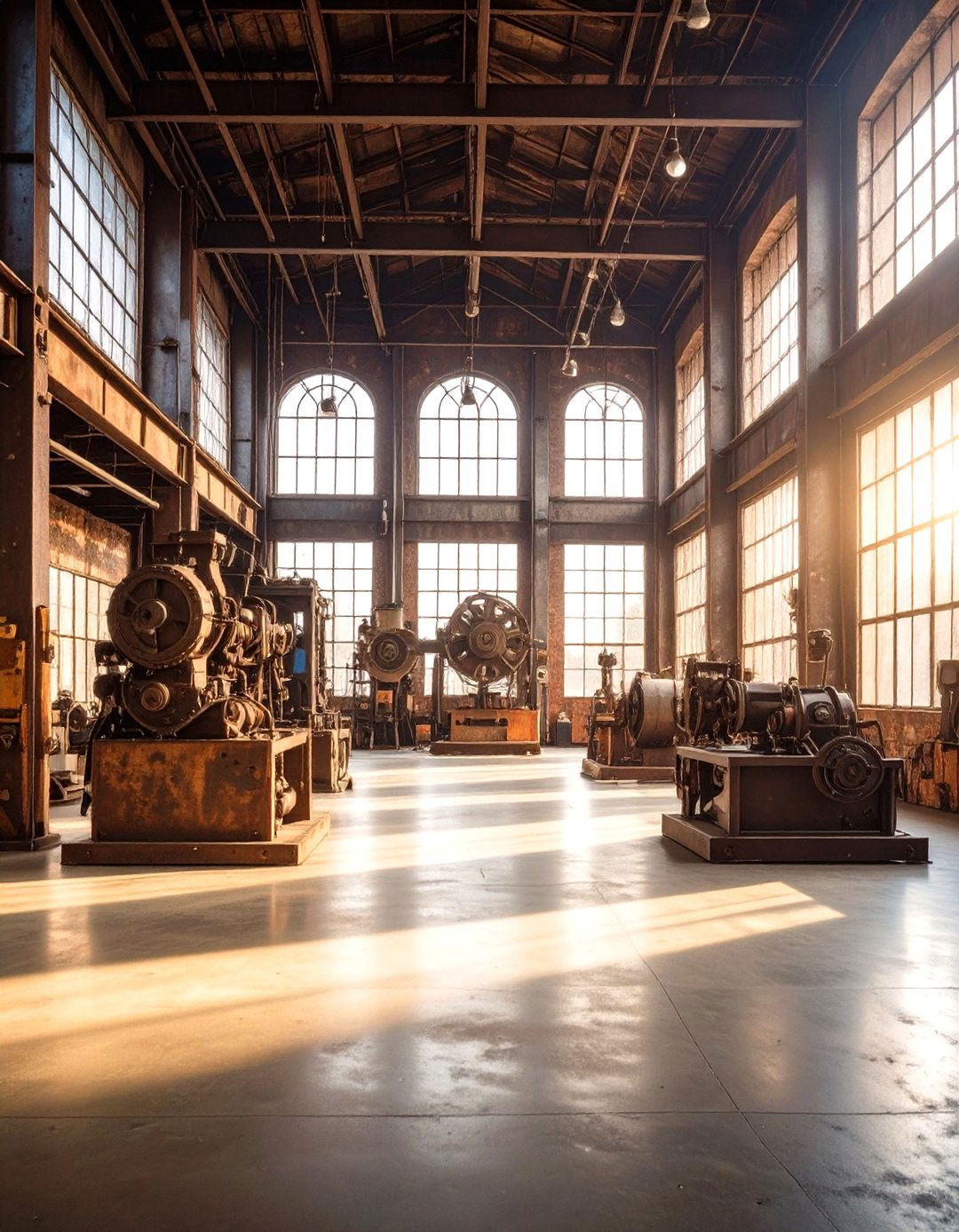
Large-scale metalwork introduces artistic expression while celebrating industrial manufacturing techniques and material properties. These installations feature welded sculptures, vintage machinery displays, and custom metalwork that serves as focal points within industrial living spaces. The sculptural qualities of industrial equipment transform functional objects into artistic statements that celebrate manufacturing heritage while providing conversation starters for guests. Scale considerations ensure artwork proportions complement room dimensions while creating dramatic impact through strategic placement and lighting design. The patina and wear patterns of authentic pieces tell stories of previous industrial use while contributing unique character that cannot be replicated through new manufacturing. Installation techniques accommodate substantial weight requirements while providing proper support and safety considerations. Surface treatments preserve authentic aging while preventing deterioration that could compromise artistic integrity or structural stability throughout the installation's lifetime.
Conclusion:
Industrial decor continues to captivate homeowners and designers by transforming raw materials into sophisticated living environments that celebrate authentic craftsmanship and utilitarian beauty. This design approach successfully bridges the gap between commercial and residential aesthetics, creating spaces that feel both substantial and livable. The versatility of industrial elements allows for personal expression while maintaining connection to manufacturing heritage and architectural authenticity. By embracing exposed structural elements, celebrating honest materials, and choosing furniture that prioritizes function alongside form, industrial decor creates environments that improve with age and use. Whether implementing a complete industrial transformation or incorporating selected elements into existing designs, this aesthetic offers lasting appeal that transcends temporary trends while providing practical benefits for modern living.


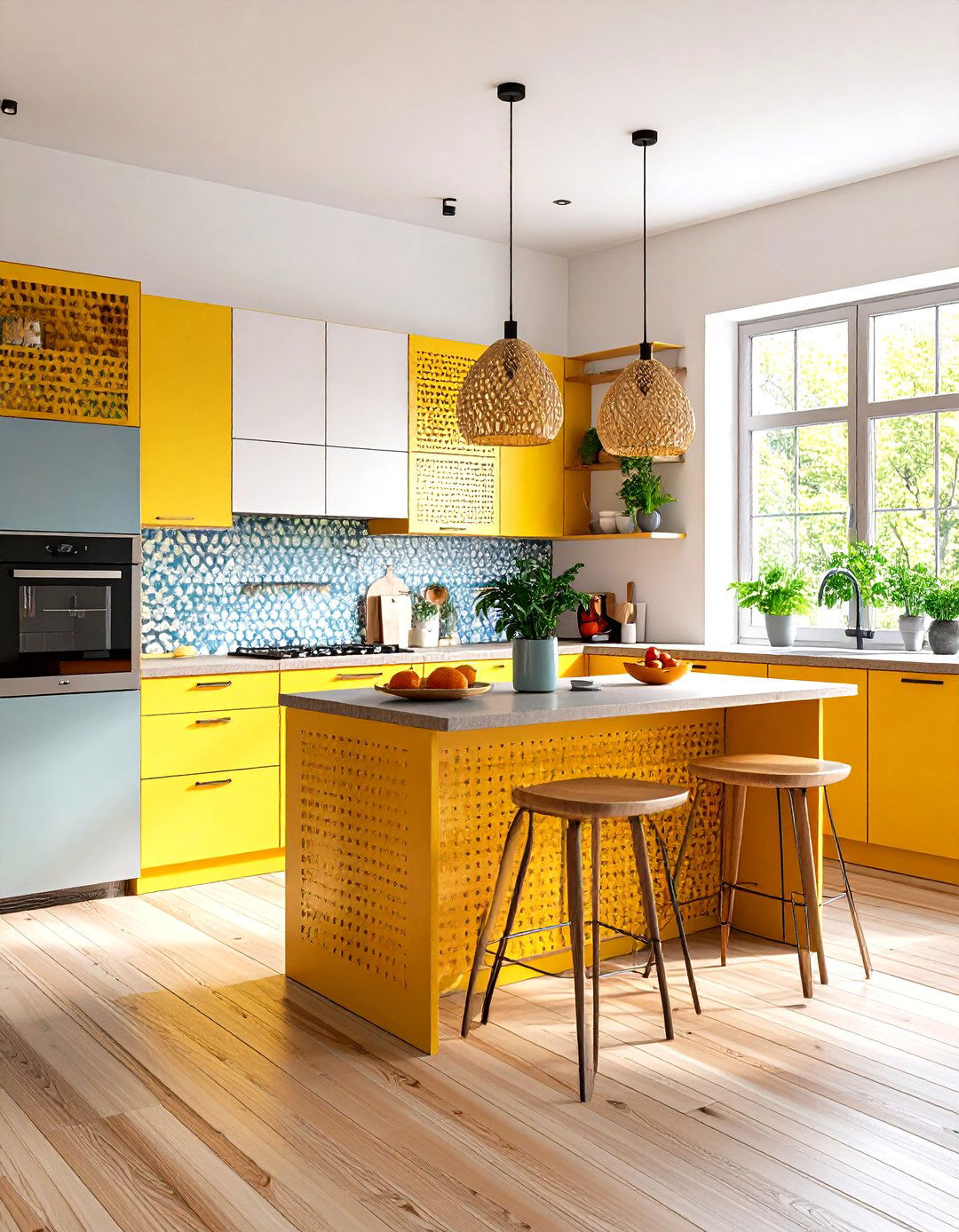

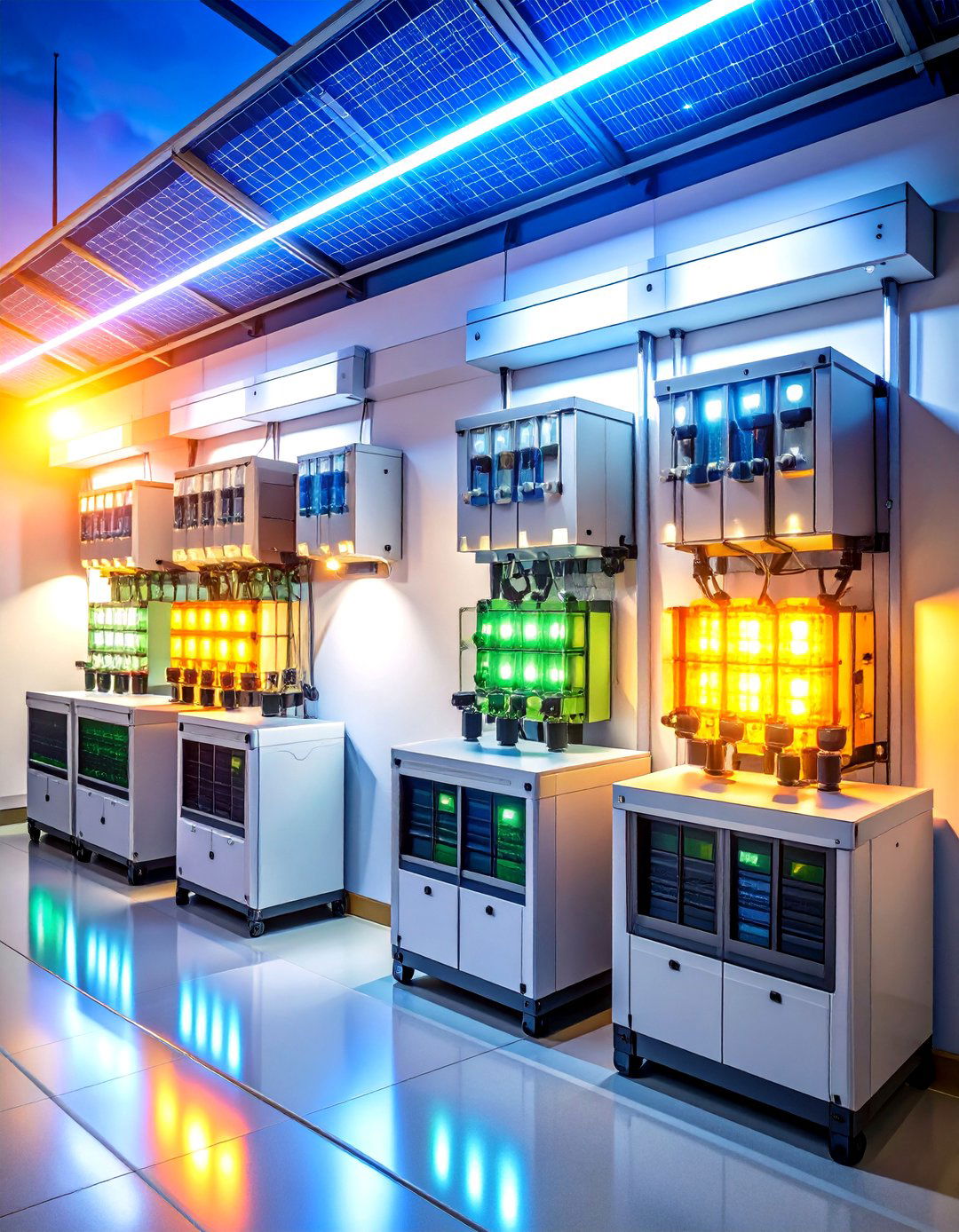

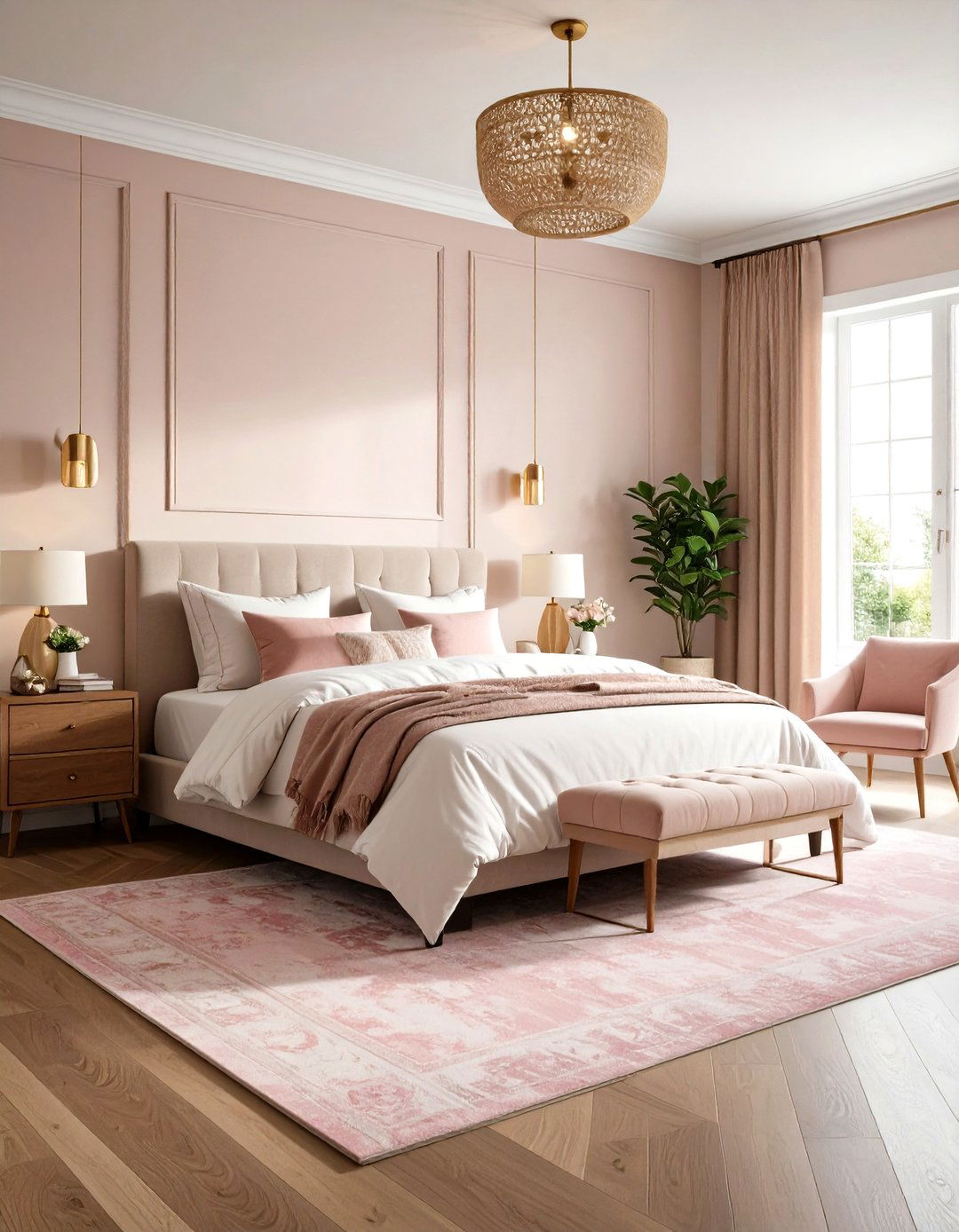
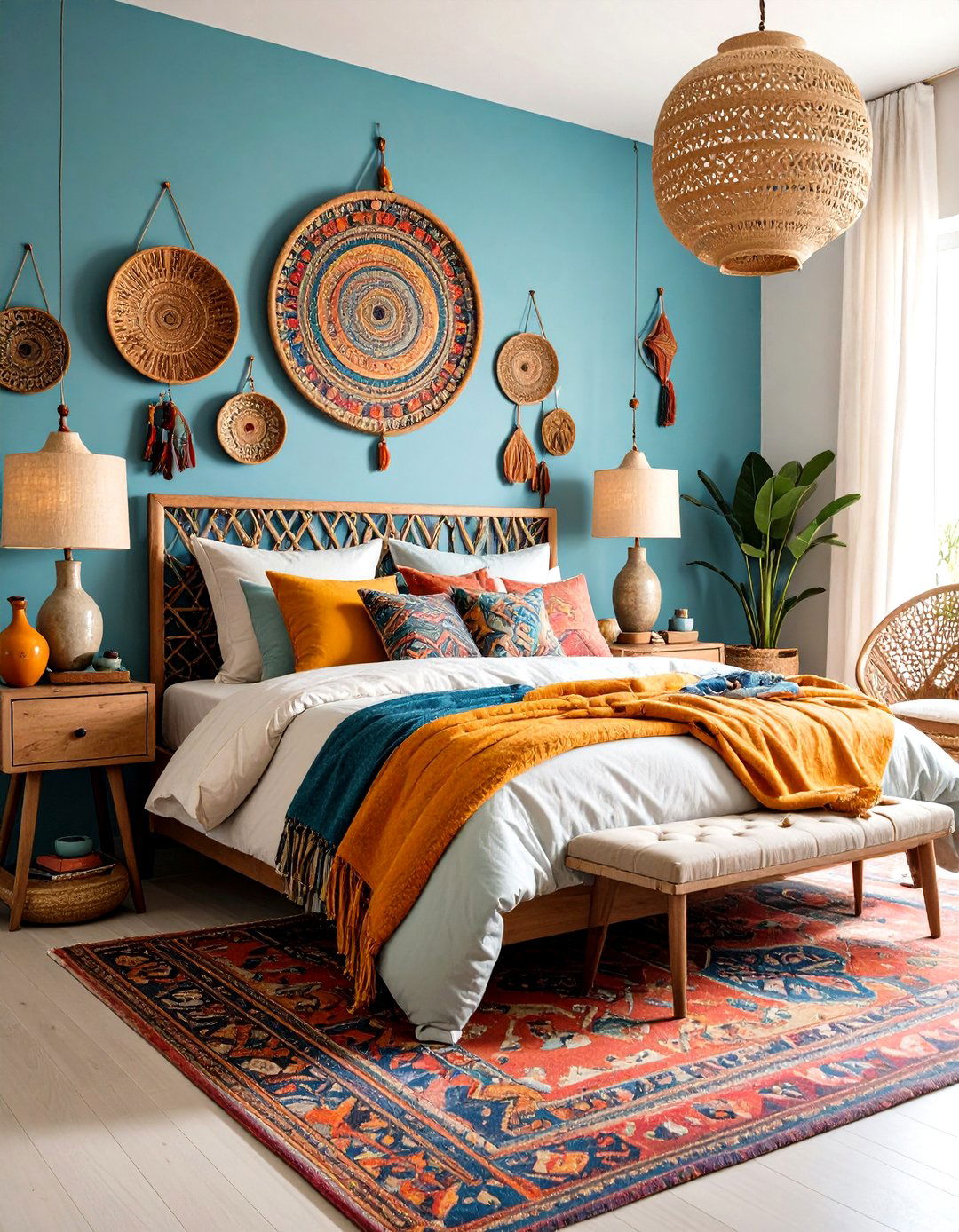

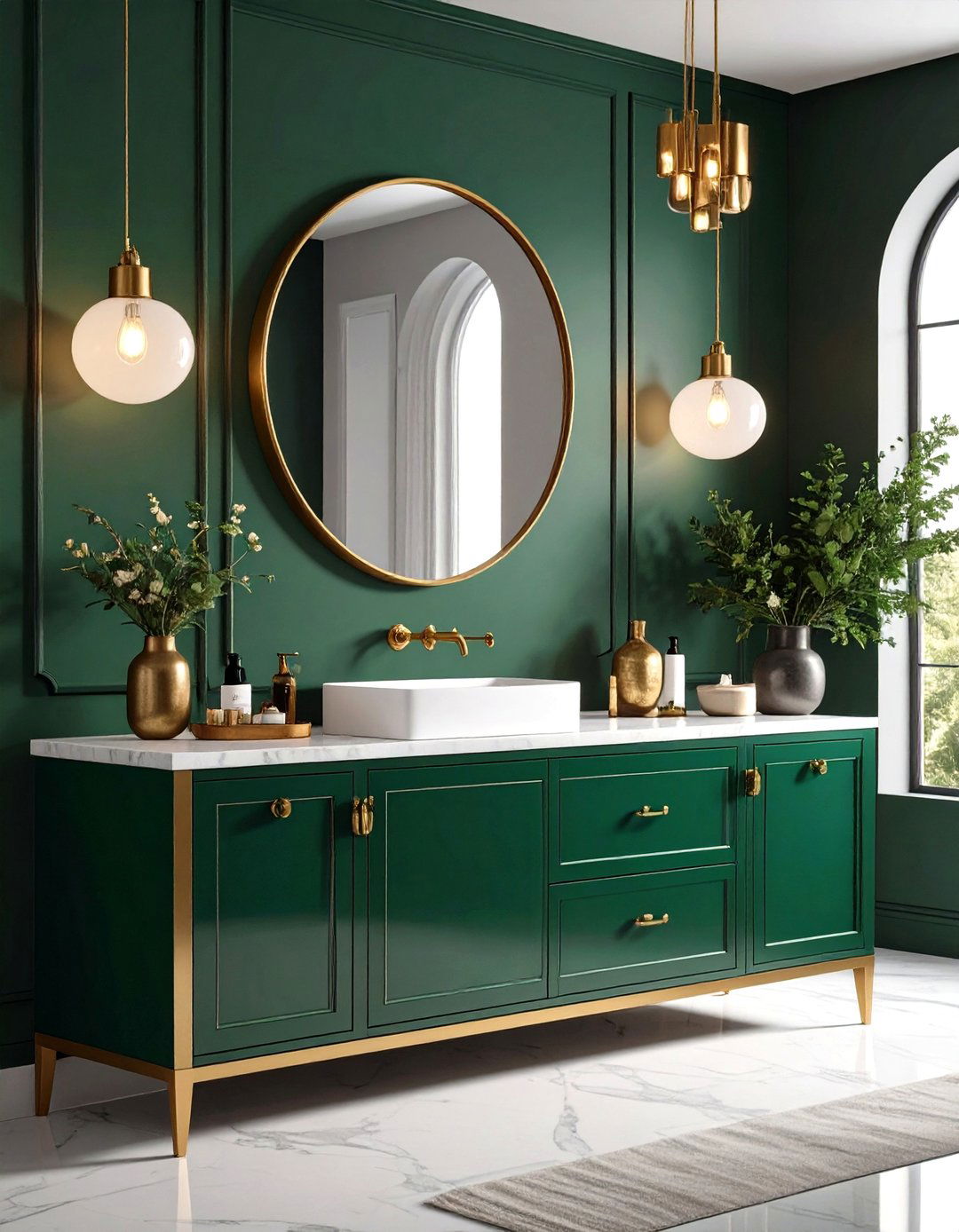
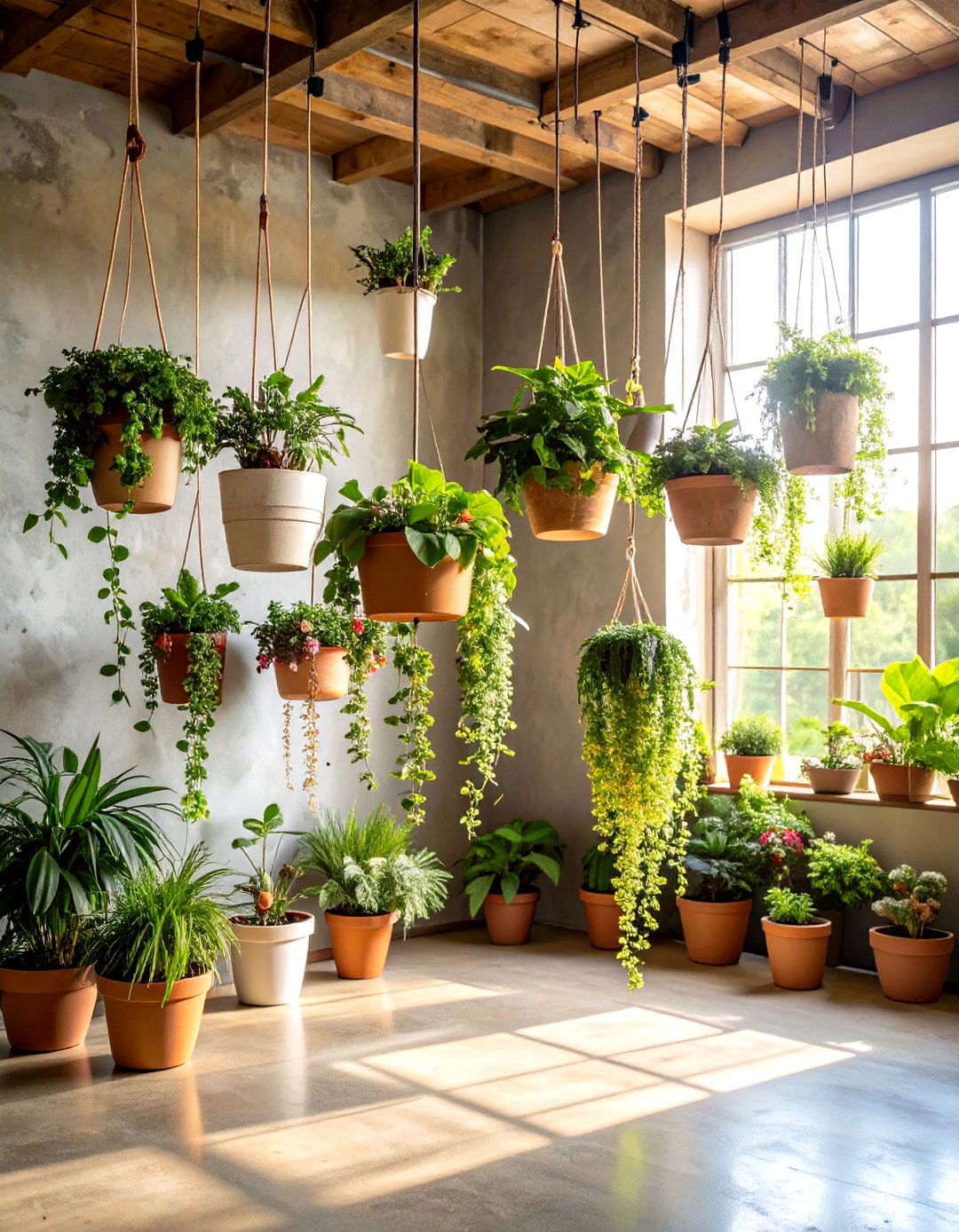
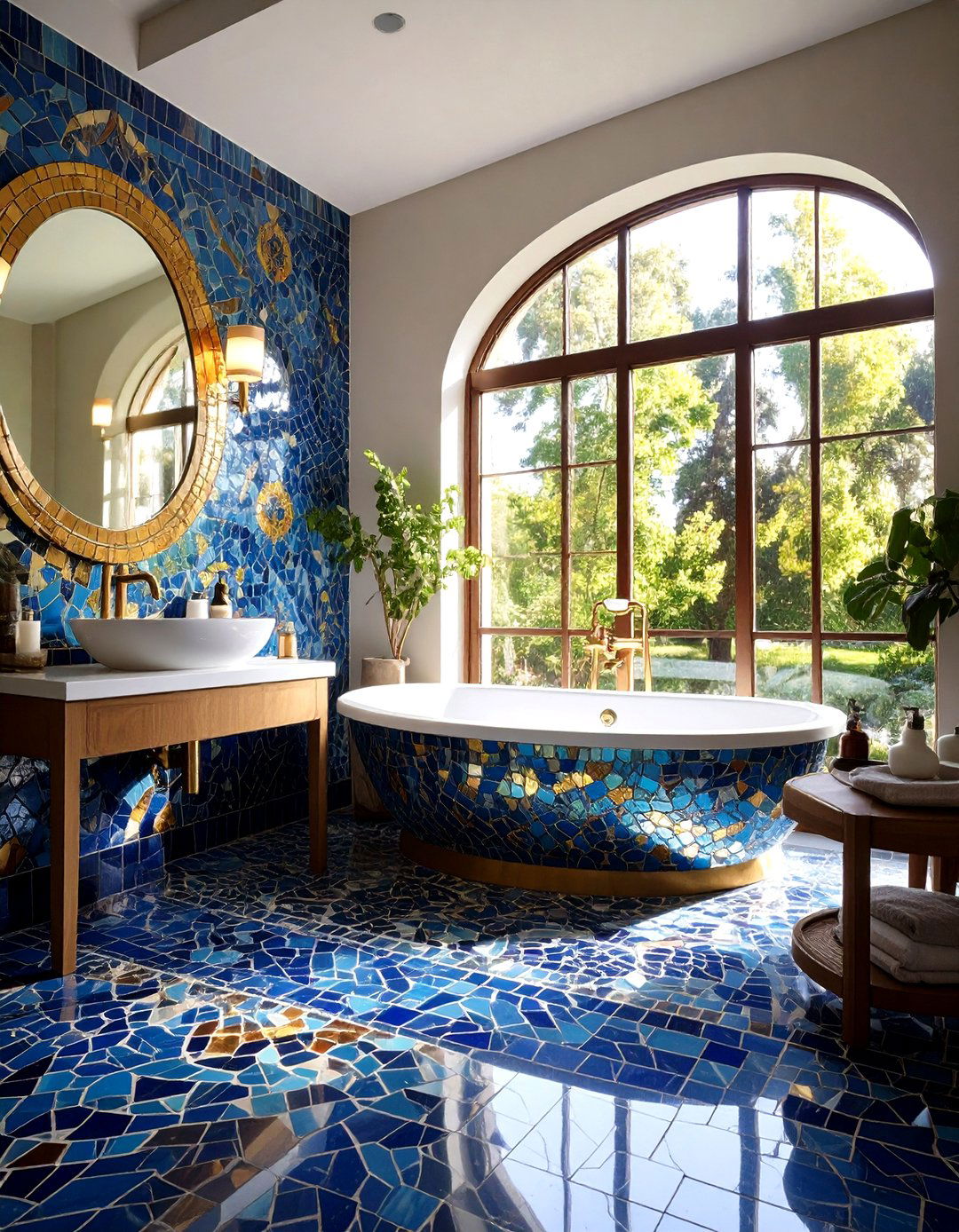

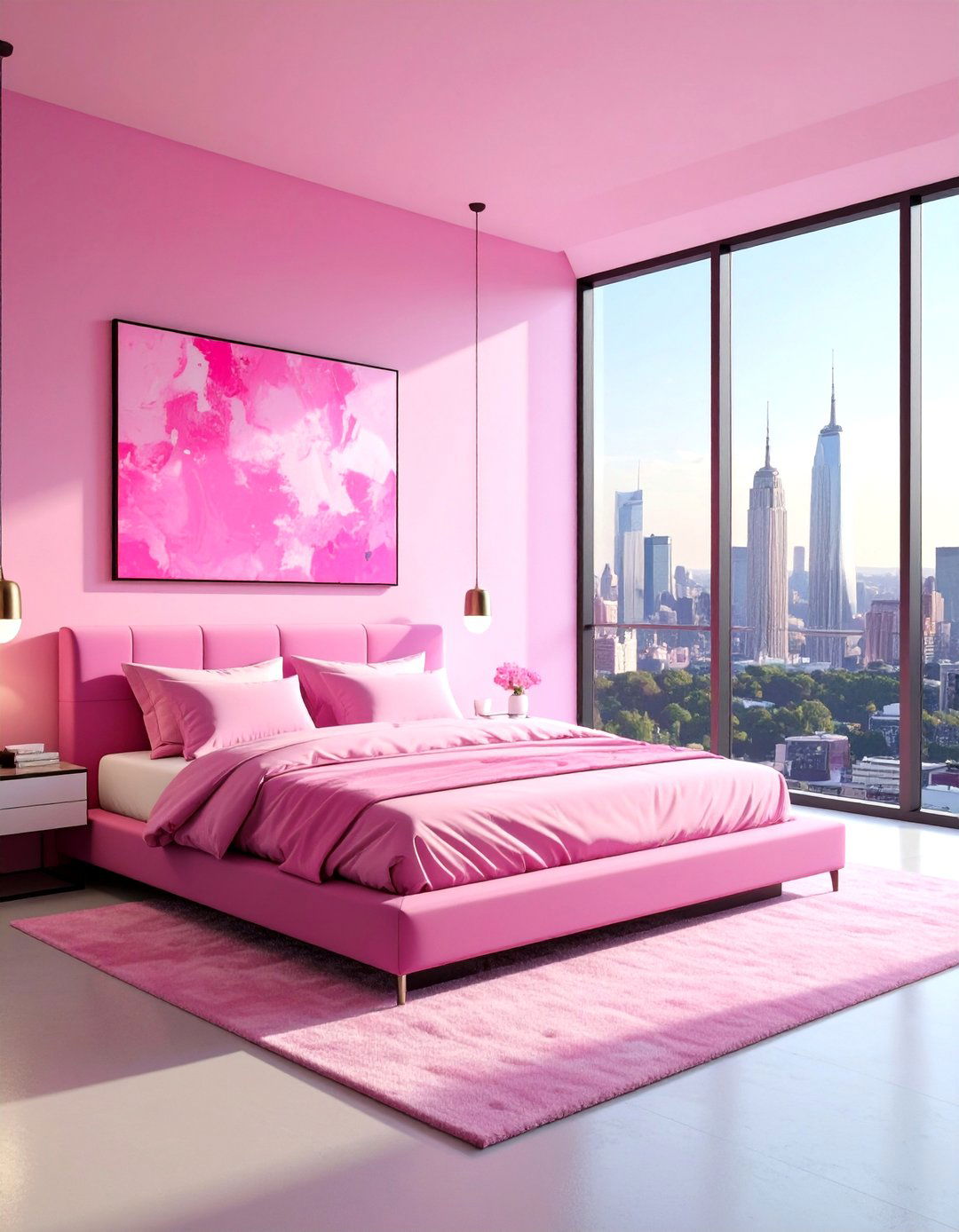
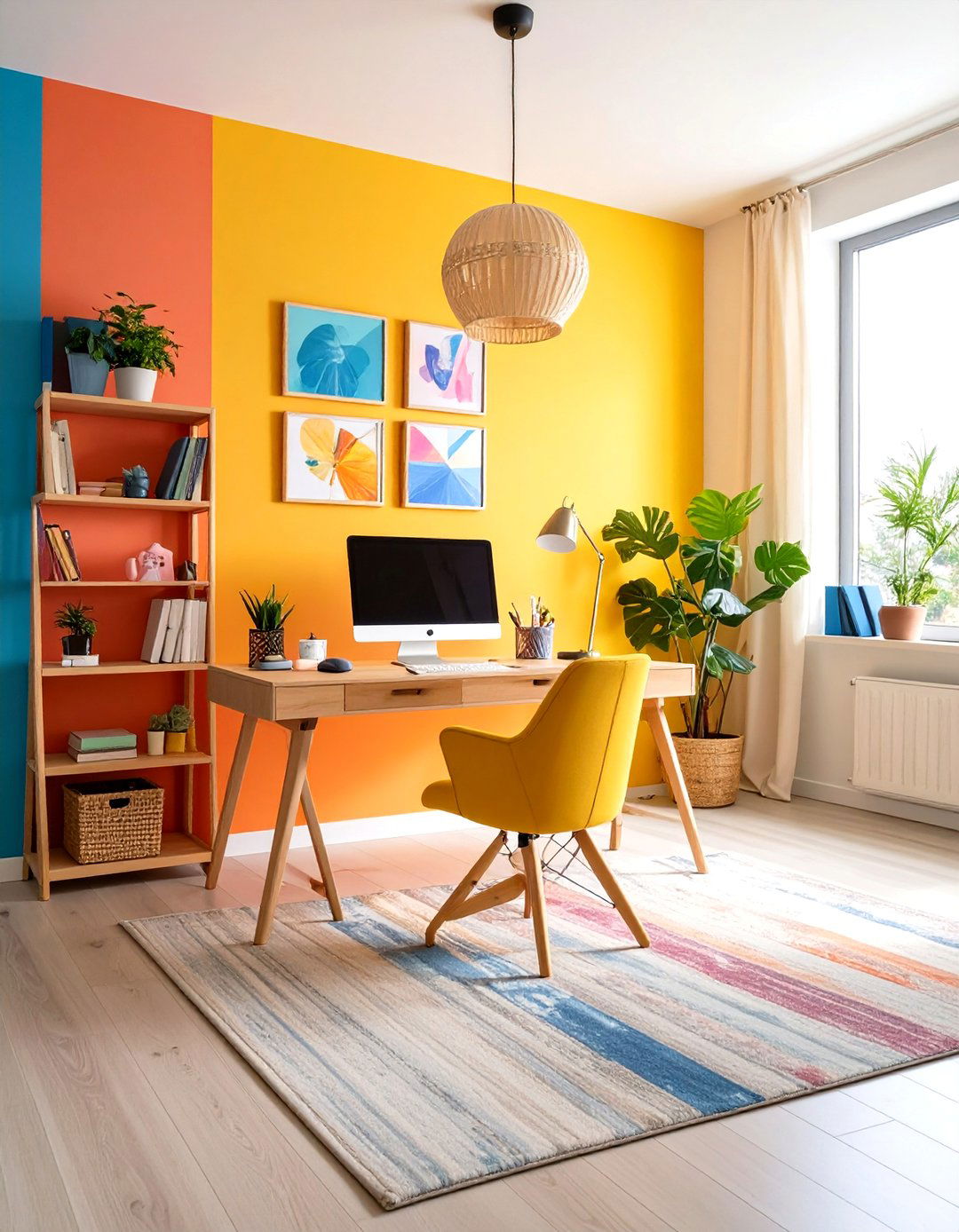



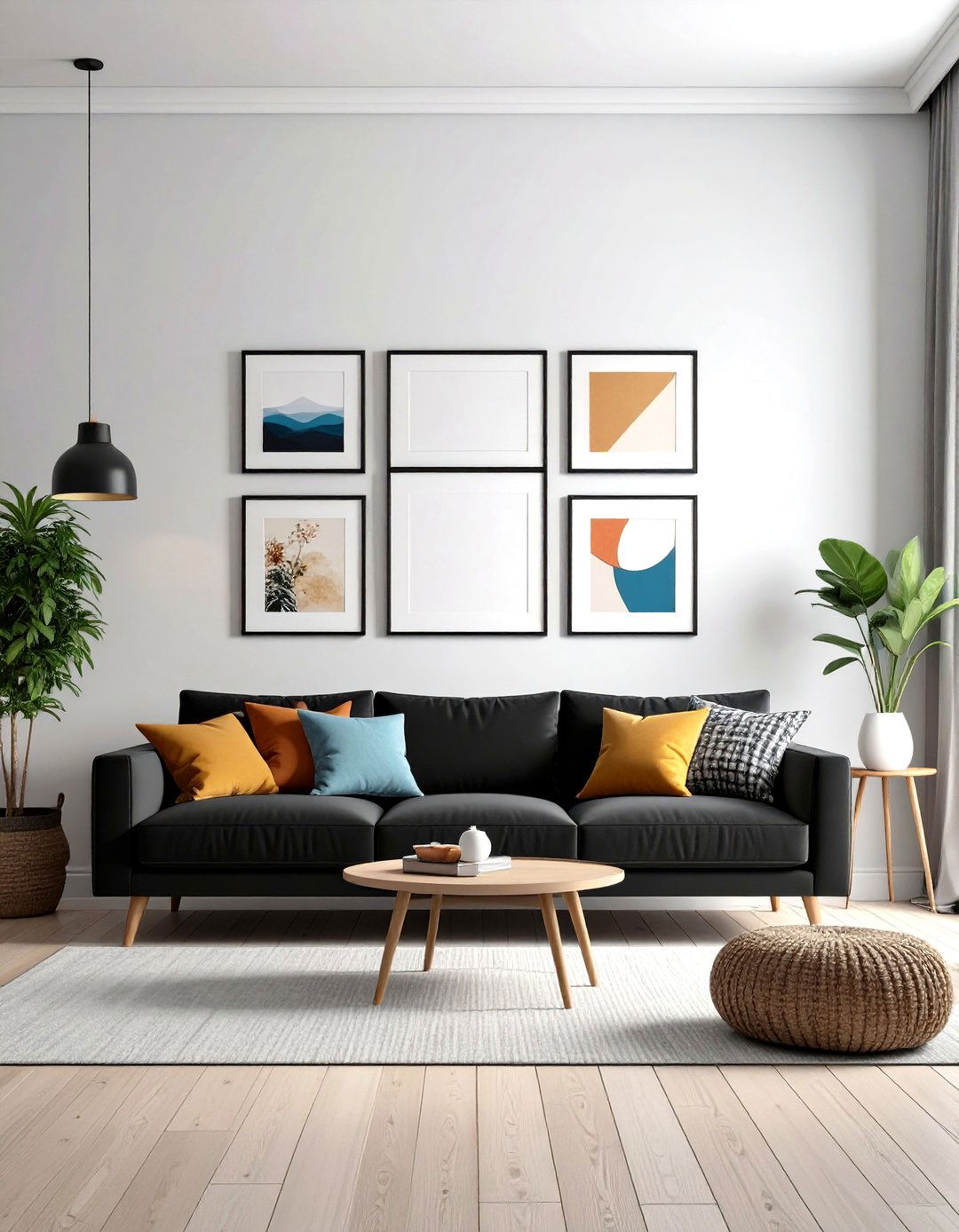

Leave a Reply